PATROL: Military Roleplay in the 20th Century by GimpInBlack
Goodbye Sweetheart, Hello Vietnam
Original SA postWell, I haven't been around here in a while, but hey, I found this pretty cool game the other day and I figured I'd share it with you goons. So grab your M16, put some Creedence on the 8-track, and get to the chopper, because we're going to Viet-fuckin'-nam in...
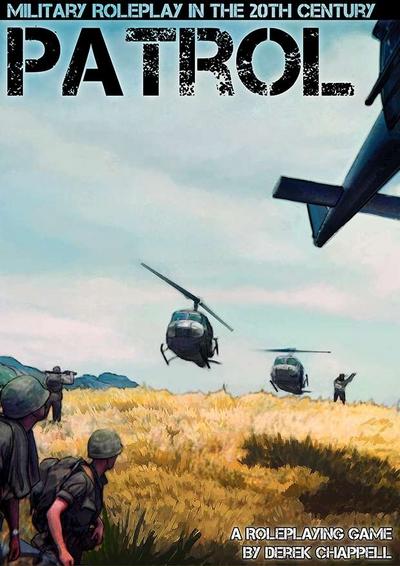
Table of Contents
- Part One: Goodbye Sweetheart, Hello Vietnam
- Part Two: Fortunate Sons
- Part Three: Run Through the Jungle
- Part Four: Paint it Black
PATROL is a 2015 game by Erika Chappell (yes, that cover image has a different name; I'm following the author's Patreon account and not asking questions that aren't my business) of Newstand Press. As you can probably tell, it's a game about the Vietnam War--more specifically, it's about a US Army Infantry squad in the Vietnam War. It bills itself as a spiritual successor to The RPG Company's Recon and Palladium's The Revised Recon, and takes its main inspiration from Oliver Stone's Platoon and Michael Herr's Dispatches.
I'll be honest, I nearly passed this game by when it cropped up as the Deal of the Day on DriveThruRPG a couple of weeks ago, because IME the sort of game described as a spiritual successor to an early 80s wargame about the Vietnam War and the sort of game that creepily fetishizes the Vietnam War is a lot closer to a circle than a figure-eight. Luckily for me (but perhaps unluckily for anyone hoping for a CthulhuTech-level trainwreck), PATROL is not that game. It's actually a quite interesting examination of the psychological stresses of being in a combat zone and the sort of primal reactions people have to them. It's a squad-level tactical combat simulation, yes, but it's about people trying to survive the horrors, both physical and mental, of war while inevitably, tragically, contributing to it.
Sound fun? I think so. It bears a lot of influence to the kind of storygames I'm a big fan of, and while it doesn't get bogged down in the minutiae of 5-food grid squares or action-by-action resolution, it has enough crunch to make engagements feel satisfying, which in turn gives more weight to the fallout in the aftermath. It does, however, suffer from some scattershot organization, and despite crediting four editors, the text has a fair number of typos and errors. But if you can work past that, the game has a lot going for it, including a really interesting alignment system (and there's a sentence I never thought I'd type).
Introduction
“Patrol went up the mountain. One man came back. He died before he could tell us what happened.”
- Quoted in Dispatches from the Vietnam War, Michael Herr
With that cheery quote, the book opens with a pretty decent one-page summary of the Vietnam War, its history, and why it was such a shitshow on both sides. We'll get a much more in-depth overview later in the book, so I'll wait till then to talk about it and get to the game itself.
Basic Training
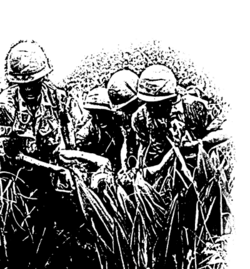
All the art in the book is pulled from public-domain photos from the war, treated with filters into these impressionistic silhouettes. I like it.
After the obligatory "this is how a role-playing game works" section, we get to the first rules. Right away the game shows off its storygame DNA, because the first rules are best practices for good play, not task-resolution mechanics:
- Your Character is Yours: Nobody else gets to say what your character does, or make up things about them without your consent.
- Bad Things Happen: Vietnam fucking sucks. People die, often suddenly, sometimes capriciously, usually bloody. Bad shit happens to good people, and that's in large part what the game is about, so be ready for it.
- No Going Back: Pretty self-explanatory. No backsies if something doesn't go your way.
- Off Limits: The flip-side of the previous two rules: Vietnam fucking sucks, and while PATROL can go to some pretty dark places, it's important to have a frank discussion before play about what's off-limits for your table, and then to respect that.
- Give the GM Some Room: The GM in PATROL isn't God, and her word isn't law--she should follow the rules as much as the other players. That said, if she fudges something in the moment or makes an ad hoc ruling to keep the momentum up, let it slide.
- Put Your Phone Away: Come on, don't be That Guy.
On the other hand, every 1 you roll is a Failure. Some actions have drawbacks based on Failures rolled, but if you roll more failures than successes, your action has gone FUBAR. A FUBAR action doesn't necessarily fail--as long as you hit the Difficulty, you still do it--but something goes very, very wrong. Vietnam fucking sucks.
Character Creation
First things first, the game advises you to have a chat about themes they might want to explore and how historically "correct" they want the game to be. For example, though the US Armed Forces were racially desegregated in 1948, women and openly-LGBT people weren't allowed in combat roles in the 1960s-70s, but maybe you'd rather ignore that. Likewise, while the game generally assumes a nebulously late-60s setting, you might want to anchor your game more specifically to a particular time period. Later in the book we'll see rules modifications for setting your game notably earlier or later in the conflict, bu for now we'll cover the baseline. Finally, these rules assume you'll be creating US Army GIs--the GM's section of the book has adjustments for playing everything from US Marines to ARVN Rangers to Viet Cong and more, but we'll be sticking with infantry grunts for now.
The first step, of course, is concept and name. Once everybody has a general idea of who they want to play, you go around the table and introduce your characters. Then, everybody else at the table gets to pick a nickname for your character. No, you don't get any say in your own nickname, what kind of asshole tries to give himself his own nickname? Next is your Serial Number, because if you're captured you need to be able to repeat Name, Rank, and Serial Number, right? Your SN is an 8-digit number, with the first digit indicating whether you were a volunteer, a draftee, or National Guard, the second digit showing the state you were inducted in, and the rest being random numbers you can make up as you like. Next you'll roll for your blood type, because you're probably going to need a transfusion at some point. Finally, you write down your helmet scrawl: what little slogan, image, or pattern do you write on your gear with a ubiquitous black marker?

Every soldier starts with a basic kit that includes a few skills and general-issue equipment. The game doesn't bother tracking little things like maps, mess kits, camo face paint, etc.--just the big, important stuff. You also get a choice of a battle rifle or an assault rifle--we'll learn the difference in the Equipment chapter later (broadly, battle rifles are worse at suppressing fire and better at precision shooting, while assault rifles are mid-range on both).
You might think the next step would be Attributes, but no, they come later--because you need to know your Military Occupational Specialty (MOS) first. MOS is a bit like character class, but less defining. Your MOS gives you one unique ability, a couple of Skills, and maybe a piece or two of equipment. There are twelve of them, and with the exception of Rifleman, it's one to a squad:
- The Rifleman is the generic grunt. They're generalists, which makes them good for NPC "extra" squad members, new players who don't want to muck with complicated systems, or team leaders who have enough other shit to worry about. They get a +1 to all Attributes.
- The Radio Operator is your squad's lifeline. They carry the bigass radio backpack that keeps you in touch with base--and more importantly, with the big fat artillery back at base. If you like playing mages in fantasy games, the RO is for you: they use up battery charge like mana to call down hellfire, summon assistance, and generally control the battlefield. They get the ability to make certain radio- and negotiation-based actions more quickly than others. Their Skills also let them act as forward observers for artillery and airstrikes.
- The Pigman is the squad's machine gunner--so named because the M60 LMG was nicknamed the Pig. They're the kings of suppressing fire and a straightforward damage-dealing MOS. They get +5 Strength, and no that's not a typo for Fortitude, we just don't know what Strength does yet.
- The Grenadier brings the boom. If you like the tactical puzzle-solving elements of other RPGs, you'll love the grenadier and his variety of high-explosives. He gets the ability to automatically negate one Failure on any Throw Grenade Action (which, despite the name, is what you roll for grenade launchers, RPGs, or rifle grenades as well).
- The Point is your forward scout, the one who ranges ahead of the rest of the squad, looking out for enemy contact, traps, etc. They're also the de facto tunnel rat MOS--and Charlie loves to dig tunnels. They can study the tracks of other units and discern facts about that unit from them.
- The Marksman is the sniper. Duh. Not much else to say; they get bonus damage when they Take Aim at a target, pretty standard.
- The Firebug
commits war crimescarries the squad's flamethrower, a terrifying bunker-clearing, jungle-annihilating walking atrocity. When they set something on fire, they get to roll damage three times and keep the highest result.
- The Gunner handles any and all additional heavy weapons--mortars, heavy machine guns, anti-tank rifles, whatever. Their special ability is that, before any mission, they can pick a heavy weapon. For the duration of the mission, they get Skill with that weapon and get one free of charge.
- The Medic is not just your party healbot, they're also your surefire way to winning hearts and minds when you roll into a village--someone's always sick or hurt, after all. They're also a good fit for players who aren't totally down with the darker themes of the game. Their special ability is that they can automatically reduce someone's ongoing damage when they treat them. They also get free
heroinopiates. For medicinal purposes.
- The Intel is the face and brains of the squad. They're really good at getting people to trust them, and they get a discount on hallucinogens.
- The Handler has a dog. Their special ability is Has a Dog. So if you ever wanted to inflict the horrors of Vietnam on a big ol' German shepherd, this is your MOS.
- Finally, The Engineer builds shit, from roads to bridges to defensive positions. They get huge bonuses to preparing positions before a battle and can set traps with aplomb, but they tend to fade into the background once fighting starts.
Now it's time for Attributes. This is really straightforward: You have 24 points to divide between the three Attributes, with a minimum of 5 in each. Technically it says you have up to 24 points, but there's no real reason you'd ever spend less than that. These are your Base Attributes--in practice, equipment, status effects, and other rules will modify these significantly.
Now it's time to do some light customization. You get 6 XP to spend on additional Attribute points, Skills, or equipment. Yes, equipment costs XP in this game--but only permanent equipment, and only stuff beyond your standard kit and your MOS gear. Consumables like ammo, food, or grenades are free.
Finally, there's the issue of Rank. As far as PATROL is concerned, there are only 5 ranks to worry about : Officers (LOLNope, you'll never be one of these), Sergeant, Specialist, Private First Class, and Private. Most likely, you're a Private. The more technically-inclined MOS (i.e. anything but Rifleman) might start out as PFCs or Specialists, but then again maybe not. The GM is encouraged to choose (randomly "or maliciously") one PC to be Sergeant. The highest-ranked PC in the squad gets to settle any disputes over group actions in which the whole squad participates and is usually in charge of any NPC allies, but the game is very clear that out in the field, rank carries no actual authority--in other words, you get to facilitate, not be an authoritarian dick.
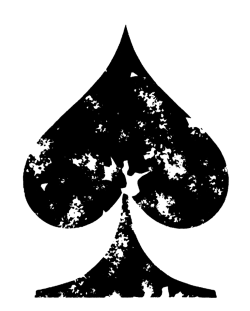
Next Time: Fortunate Sons - Character creation demo! Give me a few grunt concepts and I'll make a few characters to illustrate the system. Be sure to include MOS and whether they were drafted or not, and from what state, and bonus points if you throw in a period-appropriate photo reference.
Fortunate Sons
Original SA post
Table of Contents
- Part One: Goodbye Sweetheart, Hello Vietnam
- Part Two: Fortunate Sons
- Part Three: Run Through the Jungle
- Part Four: Paint it Black
In the late summer of 1967, a USMC sniper team went into the jungle near Ta Dath to seek out and assassinate a Viet Cong officer on the Cambodian border. Contact with Firebase Katum was lost four days later. When contact was not reestablished within 2 days, S&R operations were undertaken by 2nd Platoon, Goon Company. This is the story of 1st Squad, 2nd Platoon:
- SGT Andre "Dutch" Jackson
- SPC Walter "Radar" O'Reilly
- SPC Frank "Ferret Face" Burns
- PFC Jenette "Alien" Vasquez
- PVT Martin "Ratcatcher" Sigmar (& Bastard)
- PVT Le Duc Quan (ARVN)
- PFC Frank "Punisher" Castle (USMC)
(With apologies to Beetle, Armin, and the unnamed ROK Marine. Cartoon characters don't posterize well and we're already doing two non-standard characters, respectively.)
Carrying Capacity
Before we actually start with the characters, we need to skip ahead a bit to cover encumbrance and carrying capacity, because even though it's not covered until the Movement rules in the book, it matters to character creation.
All equipment (at least, all equipment that's worth tracking) has Weight, which is an abstraction of how heavy and awkward it is. (An adult human has a maximum Carrying Capacity of 10 Weight--it doesn't matter how strong you are, it's a matter of where to put all that stuff. Clothing you're wearing is treated as 0 Weight, and Equipment like Backpacks, Web Belts, etc. increase that capacity by giving you more space to store stuff.
Where strength comes into play is in how much your gear slows you down: You have a Strength rating equal to double your Fortitude Attribute. Remember how Pigmen get a +5 to Strength? Now you know what that means. Total up the Weight of all your gear and subtract the result from your Strength, and that's your Load. Cross-reference that with the Move Speed Chart and you get your Speed, which in turn dictates how far you can move in a Turn. It's a little convoluted, but doing it this way gives you a Speed that can easily modify with things like terrain and other modifiers.
Throughout the writeups, Skills and Gear marked * is the standard-issue gear for a starting character, while those marked ** are from MOS. I'm also not going to bother stocking all these characters up on consumables like ammo or food, because that would take way too long.
Cool? Cool.
SGT Jackson, Andre "Dutch"
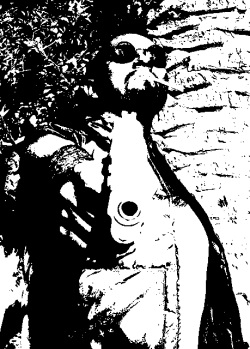
NB I have never watched Black Lagoon so I have no idea how accurate any of this is, I'm just going with what makes sense for the squad.
SN: 12040806
Blood Type: A+
MOS: Point
Alignment: Righteous
Attributes: Fortitude 6, Vigilance 10, Proficiency 8
Skills: Assault Rifle (Medium)*, Battle Rifle (Medium)*, Basic Medical*, Detect Trap**, Guard*, Hand Grenade*, Observation**, Prepare Position*, Shotgun (Close), Stealth **
Equipment: Fatigues (Wt 2, Negated)*, Footwear (Wt 2, Negated)*, Shotgun (Wt 2), Steel Helmet (Wt 2)*, Poncho (Wt 2)*, Webbing Belt (Wt 0, +10 Capacity)*, Haversack (Wt 2, +10 Capacity)*, Entrenching Tool (Wt 2)*, First Aid Kit (Wt 1)*, Gas Mask (Wt 2)*, Knife (Wt 1)*, Machete (Wt 2)**, Dog Tags (Wt 0)*
Speed: 8 (Total Load: 4)
Dutch is the squad leader and, in my version at least, the pointman. Points need a shitton of Vigilance and to travel light enough to maintain mobility, so he ditches a decent amount of his starting gear--this doesn't give him any XP refunds, but it lightens his load--he ditches a Field Jacket (it's high summer after all), Flashlight (just gets you shot in the dark), Flak Jacket (too damn heavy), and Military Pack in favor of a smaller, lighter Haversack. His 6 XP go to a combat shotgun and the Skill to use it at Close Range.
SPC O'Reilly, Walter "Radar"

SN: 17012570
Blood Type: B-
MOS: Radio Operator
Alignment: Idealistic
Attributes: Fortitude 6, Vigilance 14, Proficiency 6
Skills: Assault Rifle (Medium)*, Battle Rifle (Medium)*, Basic Medical*, Electronics**, Forward Air Controller**, Forward Observer**, Guard*, Hand Grenade*, Prepare Position*
Equipment: Fatigues (Wt 2, Negated)*, Footwear (Wt 2, Negated)*, Assault Rifle (Wt 3), Steel Helmet (Wt 2)*, Flak Vest (Wt 4)*, Poncho (Wt 2)*, Webbing Belt (Wt 0, +10 Capacity)*, Entrenching Tool (Wt 2)*, First Aid Kit (Wt 1)*, Dog Tags (Wt 0)*, Portable Radio Telephone (Wt 6)
Speed: 7 (Total Load: 8)
Radar has to carry the squad's radio, which is heavy as fuck and takes up his backpack slot, so he has to ditch a bunch of stuff just to come in under his carrying capacity. He spends his 6 XP on 1 point of Proficiency and 2 more of Vigilance, because c'mon--he's Radar!
SPC Burns, Frank "Ferret Face"
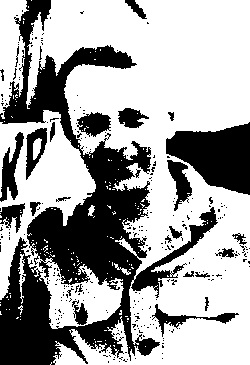
SN: 15102939
Blood Type: B+
MOS: Medic
Alignment: Egocentric
Attributes: Fortitude 9, Vigilance 10, Proficiency 5
Skills: Assault Rifle (Medium)*, Battle Rifle (Medium)*, Basic Medical*, Diplomacy, Guard*, Hand Grenade*, Medicine**, Prepare Position*, Survivalist, Trauma Care**
Equipment: Fatigues (Wt 2, Negated)*, Footwear (Wt 2, Negated)*, Assault Rifle (Wt 3)*, Steel Helmet (Wt 2)*, Field Jacket (Wt 2)*, Flak Vest (Wt 4)*, Poncho (Wt 2)*, Webbing Belt (Wt 0, +10 Capacity)*, Military Pack (Wt 4, +15 Capacity)*, Entrenching Tool (Wt 2)*, Flashlight (Wt 1)*, First Aid Kit (Wt 1)*, Gas Mask (Wt 2)*, Knife (Wt 1)*, Dog Tags (Wt 0)*, Medical Bag (Wt 3)**
Speed: 7 (Total Load: 9)
Burns is a pretty straightforward "medic with a god complex." He spent his 6 XP on Diplomacy for making shady deals and Survivalist for finding the fun mushrooms.
PFC Vasquez, Jenette "Alien"
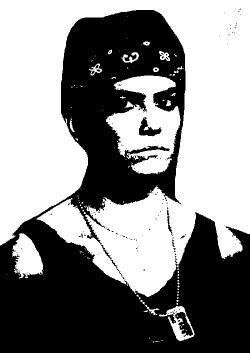
SN: 31055426
Blood Type: O+
MOS: Gunner
Alignment: Righteous
Attributes: Fortitude 10, Vigilance 6, Proficiency 9
Skills: Assault Rifle (Medium)*, Battle Rifle (Medium)*, Basic Medical, Guard*, Hand Grenade*, Heavy Machine Gun (Close, Medium, Long)**, Observation**, Prepare Position*
Equipment: Fatigues (Wt 2, Negated)*, Footwear (Wt 2, Negated)*, Heavy Machine Gun (Wt 8)**, Tripod (Wt 5)**, Ammo Box (Wt 3)**, Steel Helmet (Wt 2)*, Field Jacket (Wt 2)*, Flak Vest (Wt 4)*, Poncho (Wt 2)*, Webbing Belt (Wt 0, +10 Capacity)*, Military Pack (Wt 4, +15 Capacity)*, Entrenching Tool (Wt 2)*, Flashlight (Wt 1)*, First Aid Kit (Wt 1)*, Gas Mask (Wt 2)*, Knife (Wt 1)*, Dog Tags (Wt 0)*
Speed: 5 (Total Load: 35)
Vasquez is our first character to hit maximum Carrying Capacity thanks to her heavy machine gun, which I figure is the closest you can get to a Smartgun in Vietnam. If I were doing a "real" equipment build and worrying about spare ammo, spare barrels, food, etc., I'd hand off the tripod and ammo box to other squad members to free up more space, but fuck it. The HMG is also our first example of a multi-part weapon--before Vasquez can use it, she (and/or some assistants) will have to put it together. Still, the suppression it puts out is worth it. With no more space for gear, Vasquez drops all 6 XP on two additional range band Skills for her big gun.
PVT Sigmar, Martin "Ratcatcher"
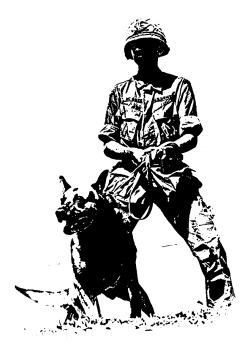
SN: 24862051
Blood Type: O+
MOS: Handler
Alignment: Pragmatic
Attributes: Fortitude 8, Vigilance 8, Proficiency 8
Skills: Assault Rifle (Medium)*, Battle Rifle (Medium)*, Basic Medical, Guard*, Hand Grenade*, Prepare Position*
Commands: Find, Kill, Recall**
Equipment: Fatigues (Wt 2, Negated)*, Footwear (Wt 2, Negated)*, Battle Rifle (Wt 3)*, Steel Helmet (Wt 2)*, Field Jacket (Wt 2)*, Flak Vest (Wt 4)*, Poncho (Wt 2)*, Webbing Belt (Wt 0, +10 Capacity)*, Military Pack (Wt 4, +15 Capacity)*, Entrenching Tool (Wt 2)*, Flashlight (Wt 1)*, First Aid Kit (Wt 1)*, Gas Mask (Wt 2)*, Knife (Wt 1)*, Dog Tags (Wt 0)*, Whistle (Wt 1)**
Speed: 7 (Total Load: 8)
Bastard
Attributes: Fortitude 10, Vigilance 8
Skills: Aquatic, Bloodlust, Fleet Footed, Guard, Melee (Teeth), Observation, Stealth
Special: Teeth (+3 Melee), Tracking (Can follow Tracks twice as long as humans)
So the way Dogs work is they get 18 points to split between Fortitude and Vigilance, but they don't get Proficiency (obviously). By default, they follow their Handler, defend themselves and their Handler in melee, Forage if they get hungry, etc., but Ratcatcher can buy Commands as Skills to get Bastard to do other things. In this case, he's spent all 6 of his XP on two new Commands: Find and Kill, so Bastard can try to sniff out the missing PFC Castle and rip out throats.
PVT Le Duc "Chatterbox" Quan
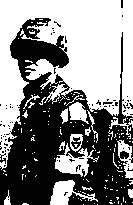
ARVN character creation is slightly modified: First, they only get 21 points to divide up between their Attributes, secondly, they have a different list of standard issue Skills and Equipment, and thirdly, they have to roll a d6 for each piece of standard-issue gear: a 1 means that, due to supply issues, they never got issued that particular gear. Hilariously, Quan rolled a 1 for both his Fatigues and his Footwear, so he's going to have to spend some XP on pants. Life's tough in the ARVN.
SN: N/A
Blood Type: AB+
MOS: Intel
Alignment: Pragmatic
Attributes: Fortitude 5, Vigilance 10, Proficiency 7
Skills: Assault Rifle (Medium)*, Battle Rifle (Medium)*, Basic Medical*, Carbine (Medium)*, Diplomacy**, Guard*, Khmer, Hand Grenade*, Prepare Position*
Equipment: Fatigues (Wt 2, Negated), Footwear (Wt 2, Negated), Carbine (Wt 2)*, Steel Helmet (Wt 2)*, Webbing Belt (Wt 0, +10 Capacity)*, Military Pack (Wt 4, +15 Capacity)*, Entrenching Tool (Wt 2)*, Knife (Wt 1)*, Dog Tags (Wt 0)*, English Phrasebook (Wt 1)**, Camera (Wt 1)**
Speed: 8 (Total Load: 3)
When 4th Platoon was sent out on a mission so close to the Cambodian border, HQ requested an interpreter to assist. Unfortunately, due to a bureaucratic snafu, ARVN sent them an interpreter who speaks Khmer, not English. Fortunately, PVT Le has an English-language phrasebook, which is better than nothing. Still. Fuckin' Vietnam. PVT Le has to spend 1 XP on his own pair of boots, plus 3 more XP on Khmer Language skill.
For his last 2, he bumps up Vigilance by 1.
PFC Frank "Punisher" Castle, USMC
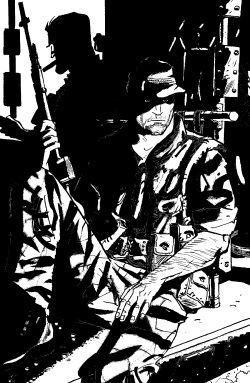
Another branch of service, another modified character creation system. All Marines get the Aquatic Skill for free, and since every Marine is a Rifleman, they get the benefits of the Rifleman MOS, no matter what MOS they choose.
NB, this is Castle as a relatively fresh USMC Scout Sniper--not the "cross-trained-with-every-damn-SpecOps-force-on-earth" version.
EDIT: Aaaaaand, I fucked up the first time around and forgot the downside of being a Marine--because of their supply chain issues, all non-free USMC gear costs +1 XP.
SN: 12129274
Blood Type: B+
MOS: Rifleman/Marksman
Alignment: Righteous
Attributes: Fortitude 7, Vigilance 6, Proficiency 15
Skills: Assault Rifle (Close**, Medium*), Battle Rifle (Close**, Medium*, Long**), Bolt Action Rifle (Medium**, Long**), Basic Medical, Guard*, Hand Grenade*, Prepare Position*
Equipment: Fatigues (Wt 2, Negated)*, Footwear (Wt 2, Negated)*, Bolt-Action Rifle (Wt 4), Telescopic Sight (Wt 2)**, Webbing Belt (Wt 0, +10 Capacity)*, Military Pack (Wt 4, +15 Capacity)*, Entrenching Tool (Wt 2)*, Knife (Wt 1)*, Dog Tags (Wt 0)*, Spotter's Dog Tags (Wt 0)
Speed: 9 (Total Load: -1)
Frank's in a bad way--turns out his mission had bad intel and he and his spotter walked into an entire Company of V.C. coming down the Ho Chi Minh Trail. Frank's spotter was killed, and Frank had to ditch most of his gear just to stay ahead of the enemy. He's spent the last week playing cat and mouse, taking out V.C. officers as the opportunity presents itself, but he's running low on ammo and he's reduced to foraging for food and water. He's spent 4 XP on a bolt-action sniper rifle (actually 5, see the edited note above), and the remaining 2 (actually 1) went to boosting his Fortitude.
Whew! That took a fair bit longer than I meant it to. Character creation isn't terribly complex in this game, but it involves a lot more flipping back and forth than I initially realized. Not too bad if you're just making one character, but like a jackass I went ahead and built seven, and that's without fiddling with supplies and consumables--assume most of these characters would have an additional 5-10 Weight (or more) of ammo, rations, grenades, and the like. In particular, it's likely everybody in the squad carries some spare ammo for Vasquez's HMG, and someone (probably Dutch) has a smoke grenade to mark an LZ for the Medevac chopper.
In an actual game, I'd probably flesh the squad out with 4-6 generic NPC riflemen, just to have some extra bodies to absorb hits and some grunts to do the boring work, but for now, I'm calling it done. Oh wait:
 CONTEST TIME!
CONTEST TIME! I like doing these in F&Fs, so I tell you what: Hidden in the Serial Number of everyone in the squad is an easter egg reference to their inspirational character/source material (except Le, because he's a general concept and I don't know what ARVN SNs look like). First person who figures out all of them gets a copy of PATROL on me. You can post them in the thread or email me at my user name at gmail. As a reminder, the first two digits are determined by draft status and origin, it's the last 6 you should be looking at. Good luck!
I like doing these in F&Fs, so I tell you what: Hidden in the Serial Number of everyone in the squad is an easter egg reference to their inspirational character/source material (except Le, because he's a general concept and I don't know what ARVN SNs look like). First person who figures out all of them gets a copy of PATROL on me. You can post them in the thread or email me at my user name at gmail. As a reminder, the first two digits are determined by draft status and origin, it's the last 6 you should be looking at. Good luck!
Next Time: Run Through the Jungle - Gameplay Basics
Run Through the Jungle
Original SA post
Table of Contents
- Part One: Goodbye Sweetheart, Hello Vietnam
- Part Two: Fortunate Sons
- Part Three: Run Through the Jungle
- Part Four: Paint it Black
Now that we know how to roll dice and make characters, it's time to start looking at the actual structure of play. Today we're going to look at the basic foundations, with specific elements like movement, combat, etc. to follow.
The standard structure of a PATROL game is, shockingly enough, an infantry foot patrol Mission. A Mission starts with a Briefing, where you learn your Objectives, then progresses through a series of ordered Turns where the PCs do stuff to try to accomplish those Objectives, then wraps up with an Epilogue where you assess the fallout of the Mission, spend XP, and get ready to go out again.
Objectives
Pretty much what it says on the tin: the Army doesn't send you out into the bush without something that at least vaguely resembles a reason, after all. Completing Objectives nets you Victory Points, which are a sort of measure of your general morale and ability to cope with the shitshow that is Vietnam. They're contrasted by Fatigue, which is a general measure of how Done With This Shit you are. We'll talk a lot more about Fatigue and VPs when we get to the section on Status Effects, but for now you should just keep in mind that coming back from a mission with more Fatigue than VPs is a Very Bad Thing. (Also, on most missions, the VPs you earn from completing Objectives won't be enough to fully offset the Fatigue you suffer, so you'll have to look elsewhere to make up the difference.) Objectives are also one way the GM has to regulate the tone of a PATROL game: a Mission whose Objective is to patrol local villages and root out V.C. agents has a very different feel than one whose Objective is to ambush an NVA column on the road or rescue a downed airman or hump a hundred klicks out into the boonies and broadcast a live reading of Shelley's Ozymandias on a seemingly-random frequency. (One of the example game tones in the GM's section is called "Saigon Gothic" and it is delightfully weird.)
Turns
Unlike a lot of RPGs, which handwave most "narrative time" and only go into a strict turn sequence in combat or other action scenes, PATROL always operates in Turns. You can blow through a bunch of Turns in a single sentence ("okay, working together it takes you four Turns to dig that defensive perimeter around the village") or spend a goodly amount of time resolving a single one, but the Turn structure is at the forefront of the game. A Turn breaks down like this:
- Players' turn
- Advance Status Effects
- Perform Actions
- Reset Suppression
- Assess Fatigue
- Enemy Turn
- Perform Actions
- Reset Suppression
- Civilian Turn
(Status Effects are important enough that they get their own section later, but we'll go over the rest of these beats here.)
Turns in PATROL are significantly longer than you might be used to in other RPGs--approximately 30 minutes, three times longer even than AD&D's. The reason for this is twofold: First, it simulates the fact that war is, by and large, long periods of abject boredom followed by a few minutes of abject terror. Even a typical engagement with the enemy is often a few frantic bursts of fire followed by a long process of falling back and repositioning for the next strike. Direct, pitched battle is pretty rare. When it does happen, you can compress the timescale of your Turns, but that doesn't change anything like how often you advance Status Effects.
The second reason is more insidious: since you advance Status Effects like Hunger, Thirst, and Exhaustion at the beginning of every turn, time becomes the way in which PATROL punishes failure. A failed action never leads to a "nothing changes" result, because you're constantly getting tired, hungry, and thirsty, which in turn forces you to make choices like "do I consume some of my ever-dwindling resources and hope we don't waste too much time" or "will the village headman be more willing to tell me where the V.C. base is if I point a gun at his face?"
Incidentally, remember how I said there's a really elegant game-design reason for limiting communication between PCs and locals besides enforcing the theme of isolation? This is it. By forcing the "face" character into a half-hour Turn structure and limiting how much information can be exchanged per action, it gives the other PCs time to do their own thing, whereas in a free-form conversation it's really easy for one player to monopolize the GM's time playing out that chat. This way the Medic can go around and treat the sick or wounded (there are always sick or wounded), the Engineer can dig a trench in case of V.C. ambush, or whatever.
At the end of the Turn, any suppression the unit is currently suffering from is reset to 0 and, for the player turn, everybody looks at their current Status Effect levels and, after having the chance to consume equipment to reduce Status Effects, figures out their Fatigue level. Although Status Effect levels can drop, Fatigue never decreases during a mission, so it's important to remember that players have a chance to mitigate Status Effects before this. More on Fatigue in the next update, and Suppression when we get to Combat, probably in 2-3 updates.
The Roundel
Keeping track of a bunch of Status Effects can be really tedious--it's easy to forget to mark them down or lose track of when you ticked them last. To combat this, PATROL gives you a sheet called the Roundel. It looks like this:
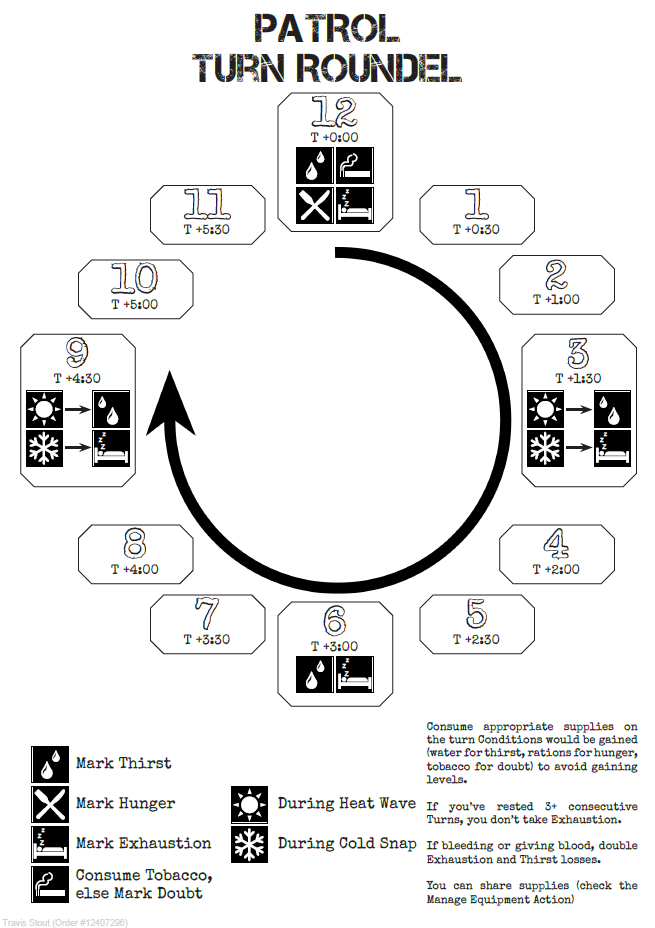
The whole squad shares one Roundel, and at the start of the Mission you put a token at the twelve o'clock spot. Then, every turn you advance the token one space on the Roundel, mark any Status Effects it tells you to, and round and round it goes. The Roundel is a harsh taskmaster--it doesn't care if the 6 Turns you just blew through consisted of two minutes of house-to-house fighting or if your replacement PC just stepped off the resupply chopper--if it says you mark a Status Effect, you mark it.
Actions
With such long Turns, you'd think PCs could do more per turn than in other RPGs, and that's true up to a point. Remember, you spend a lot of time sitting around waiting for something to happen during those 30 minutes--it's perhaps more helpful to think of Actions less as discrete actions than as an approximation of how much of your attention you're giving to various things during your Turn.
During the Player Turn, each PC gets to make one Regular Action, which is the main thing they're doing this turn--shooting, securing prisoners, or running like hell, for instance. You can also make an effectively unlimited number of Minor Actions and Free Actions--the difference being that you can only make any given Minor Action once per Turn, but you can repeat Free Actions as often as you like.
Not only is there no enforced "initiative order" within any given phase of a Turn, there's no requirement that each character take their entire turn at once. You can absolutely lay down some suppressive fire, then wait for your buddy with a flamethrower to flush the enemy out, then throw a grenade, then Shift up to a new position with the rest of your Squad. Alternately, you can Overwatch as a Regular Action, which is just a more setting-appropriate term for readying an action. One key difference, though, is that if the trigger you set for Overwatch happens, you have to take the action--so be careful about things like "I'm gonna shoot at the first thing that moves out there" if you've got friendlies in the bush.
The Map
The single most important physical element of a PATROL game is the map of the mission area. Since a bunch of the game relies on tracking the relative position of things, you really need a way to visualize where everyone is, what the terrain's like, etc. The best maps are, unsurprisingly, actual military maps that show elevation, terrain, major features, etc. which, you're welcome, future PATROL players. Actually, those maps are probably a smidge too large-scale for play; the same site has a library of 1:25,000 scale maps that are better, but not nearly as complete--only a small area around Saigon and a couple of spots on the coast are available, and I can't find a more-complete archive of that series of maps. Hey, open_sketchbook, you got any good period-accurate maps to hook us up with?
In any case, no matter what scale your map is, PATROL itself never resolves below 10 meters--for game purposes, anything within 10 meters of anything else is considered to be in the same space.
Units
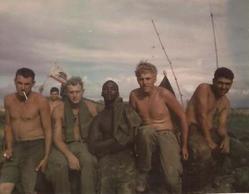
Art's a little thin in this section, so here are some soldiers.
Speaking of never resolving below 10 meters, that applies to people, too. Anybody within 10 meters of each other, regardless of whether they're friendlies, hostiles, or civilians, is considered a Unit. Units are the primary point of interaction for most of the game--you don't shoot at a specific target, you shoot at a Unit, and who you hit in that Unit is determined randomly. (You might want some different-sized polyhedral dice to make random hits easier to track.) Yes, that means that if your Point is sneaking up on that enemy sentry to garrote him and your trigger-happy Pigman starts blasting away, your buddy counts as part of that Unit. Likewise, if your Point is moving 30 meters ahead of the rest of the squad, he's considered a separate Unit. Within a Unit, we never track who is specifically where--individual members of the Unit are effectively Heisenberg Uncertainty Soldiers. The one exception to this rule is Vehicles--every Vehicle counts as its own Unit, no matter how many infantry or other Vehicles are around.
Units themselves don't act directly--individual members still do their own things. I kind of wish there was an option to "group" actions, especially for NPCs so the GM doesn't have to roll seven Suppressive Fire actions on the enemy Turn. I guess if all the enemies have the same Skills you could just roll all their dice at once, but that would mess up calculating FUBARs. Still, the comparatively low-res Unit rules and the fluid action order does a lot to provide tactical depth without getting into 30-minute debates on whether the rifleman should move 20 feet and shoot once or 5 feet and shoot twice or what have you.
NPCs
(I'm jumping out of order here a bit, because I think this makes more sense here--in the book, the next rules are for Detection, Equipment, and Moving--I'll cover them next update instead.)
NPCs have stat blocks just like PCs, though you don't generally have to worry about specifically tracking their Status Effects or Consumables. We're most broadly concerned with NPC Squadmates, Allies, and Hostile Forces.
Since most gaming groups are notably smaller than a US Army Infantry squad (typically 12-14 soldiers), you can fill out the squad with generic NPC servicemen. These guys are basically redshirts--they're nominally under control of the Sergeant's player, they never take the initiative from PCs, and they're generally there as support. They're not robots, though, and they're not totally under PC control--they'll refuse suicidal orders, retreat in the face of overwhelming odds, etc. Oh, and if a PC is hit by random fire, the player can say "nope," and shunt the damage off on an NPC. Sucks to be PVT Snafu. Alternately, in lieu of a pool of generic NPCs, you can give each PC a "battle buddy" NPC that follows their lead. This is a great way to offload the more boring jobs, like the medic's stretcher-bearer or the sniper's spotter.
Allied NPCs are either fellow soldiers you encounter in the field, or, more likely, support. Free World Forces in Vietnam have a truly ridiculous amount of support available to them. Thanks to a huge network of firebases across the country, all but the most remote parts of Vietnam are within range of artillery barrages, and helicopters for everything from Medevac to resupply to gunship support. You might even get to call in close air support from the Air Force or the Navy, but don't hold your breath--the flyboys don't get out of bed for less than an NVA regiment. There are no special rules for calling in support--PCs should know what's on-station and likely to be available to them, but if you call in an artillery strike, some artilleryman NPC back at the nearest firebase rolls his Bombard action based on the range from his guns to the target and hopes you did a good job giving him the coordinates. The idea is that by using the standard rules for this stuff, you already have the systems to determine what happens. If the Medevac chopper is on-station 5 klicks out and a Huey's max. Speed is 500 km/Turn, you know it will arrive the same turn it sets off.
Hostile forces likewise use all the same rules as other NPCs, but they have a simplified, Unit-level Status Effect track that goes from 1-5. For every member of the Unit that dies, or every three hours they go without rest while fighting the PCs, tick the track up by 1. When it passes 5, the Unit flees, gives up, or surrenders. We also get some information here about Rules of Engagement: in a Free Fire Zone, everyone and everything is considered a hostile. You're free to do things like call for artillery to saturate an entire area or shoot anyone that moves. The more common ROE is Offensive, in which you're free to engage anyone with a weapon or an enemy uniform, but you'll need visual confirmation or solid evidence of a threat to call in support fire. Finally, in a Restricted ROE, you're forbidden to fire unless fired upon, you can't plant booby traps or mines, and any artillery strikes require an observer.

Next Time: Paint it Black - Status Effects and Fatigue.
For the rest of this F&F, I'm going to be doing some surgery--the book is laid out such that it presents the basic rules for various situations, then a detailed breakdown of all the Actions in the game, then Equipment. Because that's not the most naturalistic way to talk about things, I'm going to do a vertical slice of topics--so we'll cover general combat rules, combat actions, and weapons and similar gear in one update, for example. I'm also going to skip ahead to cover Status Effects next, because IMHO it's one of the best parts of the game and combat especially builds on them.
Paint it Black
Original SA post
Table of Contents
- Part One: Goodbye Sweetheart, Hello Vietnam
- Part Two: Fortunate Sons
- Part Three: Run Through the Jungle
- Part Four: Paint it Black
Vietnam is a war of attrition (literally: kill ratio doctrine was a major part of FWF strategy), and PATROL measures that with five Status Tracks: Exhaustion, Hunger, Thirst, Injury, and Doubt. Characters start out each mission fed, watered, and rested, but between the Weight of their gear, the merciless heat and humidity of the jungle, and the exertion of combat, that won't last long. We've already seen the Roundel that tracks when to advance the Hunger, Thirst, and Exhaustion tracks, and that's the main way you'll accrue those Statuses. Some other effects tick those three--bleeding causes you to accrue Thirst faster, and a forced march can rack up Exhaustion--but mostly it's the Roundel that increases those. Unsurprisingly, you can clear them by eating, drinking, and resting (or, in a pinch, popping pills). You also have an Injury track, the source of which I hope is obvious, that you can clear with medical treatment (or, perhaps more likely for serious injury, medevac). Doubt is more involved, and we'll give it more attention in a moment.
Every level of Status Effect levies a cumulative -1 penalty to one or more Attributes: Exhausted soldiers are less Vigilant, thirsty soldiers are weaker, and hungry ones have a hard time using all that fancy gear thanks to the shakes. Injury hits you with a penalty to all Attributes, so, y'know. Try not to get shot. Maybe dig a foxhole. Doubt, meanwhile, gives you a penalty specifically to Opposed Negotiate actions, meaning that you're more easily swayed to do things you otherwise might not. Maxing out a track is very, very bad--max out Exhaustion and you just pass out, but max out Thirst, Hunger, or Injury and you're just dead. Doubt doesn't have a Forfeit like this--I'm not sure if that means it has no cap, or if it just stops at 8 with no effect.
More importantly, every level of Status Effect gives you a certain amount of Fatigue, the general measure of your "fuck Vietnam" meter. Hunger, Thirst and Exhaustion give you a small buffer before you start accruing Fatigue, but Injury and Doubt throw it at you right from the jump.
Equipment Status
Firearms and electronics also have Status Tracks for ammo and battery charge. Ammo can be magazine, belt, or feed--magazine ammo has a three-stage track before you run out of ammo and have to stop shooting for this turn (and also add 1 to your attack difficulty, for running out at an inopportune moment). Belt ammo is only a two-stage track, but when you roll off the bottom you can just expend an Ammo consumable and keep firing--though if you fire too long you might have to swap out the barrel. Finally, feed ammo isn't really a track per se, it's a simple "every time you fire, use 1 Ammo." It's for heavy weapons and artillery, mainly.
Battery tracks come in Large and Small, and have an extra wrinkle: the last few boxes on the track are "low power," which only matters for radios and reduces their effective range. Speaking of radios, remember how back in the first post I talked a little bit about how the book has some organizational problems? This is one of them, because here in this section is the only place we're told how much battery power the various radio actions use up. The radios in the Equipment section don't include that information, and neither do the various radio Actions--which, given that that's where all the other rules are for using a radio, they really should be.
Doubt
Doubt gets its own section, because it's the main engine of the Status Track system and, I'd argue, the most important rule in the game. This is the machine that drives the slow descent into madness and despair that is the hallmark of PATROL. If this mechanic didn't work, the whole game would fall apart--fortunately, it works extremely well.
Gaining and losing Doubt is heavily tied to your Alignment--there's a full-page table of common stimuli and how much Doubt soldiers of each Alignment gain or lose--for example, an Idealist removes 2 Doubt when removed from hazardous duty, but a Righteous character gains 1 for being taken out of the fight. That same Righteous character takes no Doubt for being singled out for a dangerous task, but his Egotistical buddy takes a whopping 4! The table is obviously not comprehensive, but it's a good baseline for your ad hoc rulings.
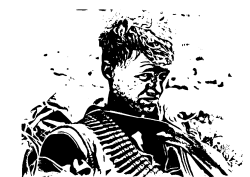
PVT Snafu is not at all sure about this shit.
Of course, repeated trauma tends to have a numbing effect--as a general rule of thumb, for every 5 Fatigue, reduce the amount of Doubt inflicted by 1. This can actually take the Doubt gained below 0 and into removal territory. Get burned out enough and even the horrors of war start to seem like a cosmic joke. This rule even applies to things that already remove Doubt, making them even more meaningful. Like, okay, it's not a Vietnam movie, but remember that scene in Saving Private Ryan where the squad, battered and exhausted, finds that record player and listens to that Edith Piaf song? And even though it's a shitty, distorted recording of a song none of them can understand, in that moment it's the most beautiful, uplifting thing in the world? That's this rule in action. Guaranteed, that song wouldn't have had the same effect on a fresh, well-rested, non-traumatized group.
I know I don't tend to editorialize a ton in my F&Fs, but I have to stop and admire just how damn elegant this rule is. A single mechanic that covers both the numbing effect of trauma and the brief rays of hope that become incredibly meaningful is just a wonderfully artful piece of game design. Bravo, open_sketchbook.
Fatigue and Victory Points
At the end of the player turn, after everybody's had a chance to counteract any Statuses gained during the Turn, you add up the Fatigue values for the highest Status Effect you have marked on each Track. If that value is higher than your current Fatigue, your Fatigue is reset to the new value. If it's lower (because you managed to clear some Status Effects), your Fatigue stays the same. There is no way to reduce your Fatigue on a mission, but if you manage to clear some Statuses you at least get a few Turns worth of buffer before you start accruing Fatigue again.
Remember how earlier we said coming home with more Fatigue than Victory Points is bad? Well, it is, and the VP you get from completing Objectives usually isn't enough to cover the difference unless the mission goes startlingly well. Fortunately, your Alignment has ways to gain VPs (and also destroy unit cohesion and make you turn on your buddies like a pack of angry badgers).
Every Alignment has six VP triggers of escalating intensity and escalating reward. For example, a Pragmatic character gets 1 additional VP from Objectives, while an Idealist can get 1 VP from helping noncombatants, prisoners, or wounded. The higher level VP rewards, however, are locked off behind Fatigue requirements--you can't use the 3 VP triggers until you have 6 Fatigue, for example. The number of VPs you gain always lags behind the amount of Fatigue you need to use the triggers, so you're always in the hole. By 9 Fatigue, Righteous characters are refusing surrenders and massacring the wounded for 4 VP, while their Righteous comrades are giving serious thought to forcibly stopping their allies from using violence. Incidentally, several of the Pragmatic options are "go along with another alignment's VP gaining action," so Pragmatists are basically giant swing votes with assault rifles. It gets exciting.

[/sub]Idealist mission of mercy or Righteous war-crime-to-be? Who knows, it's Vietnam![/sub]
Self-Medication
In the face of all that psychological trauma, is it any wonder up to 40% of American GIs were addicted to drugs in Vietnam? Patrol divides drugs into Uppers, Downers, Opiates, and Hallucinogens, and they all do various things with Status tracks. Uppers let you ignore Exhaustion and Injury at the cost of being unable to rest, for instance, while hallucinogens make you ignore anything that would give you Doubt for the duration at the cost of tripping all the balls. Like, all of them. Oh, and careful you don't get addicted, because then you'll take a bunch of Doubt if you miss your fix, or OD, because then you might die shitting your pants in the jungle.
And that's Status Tracks. It's a slick little system, and though we didn't talk much about the actual numbers, they're really well-calibrated to make you feel like you're always in the hole with Fatigue, and push you toward unlocking those high-VP reward actions. The Doubt mechanic is one of my favorite examples of a mental trauma system--I want to get more play experience with it to say for sure, but on paper, at least, it's up there with Unknown Armies' Shock Gauges for me. This was the system that convinced me to give PATROL a shot, and it does not disappoint.

Next Time: All Along the Watchtower - Detection and Movement
All Along the Watchtower
Original SA post
Table of Contents
- Part One: Goodbye Sweetheart, Hello Vietnam
- Part Two: Fortunate Sons
- Part Three: Run Through the Jungle
- Part Four: Paint it Black
- Part Five: All Along the Watchtower
We've talked about how jungle warfare is hot, sweaty, exhausting work--now it's time to talk about how you can't see shit while you're doing it. Ambushes, blind fire, and probing engagements where you never actually see the enemy are hallmarks of the Vietnam War, and PATROL has a really simple, elegant system for dealing with situational awareness that doesn't rely on slowing the game down to a crawl with umpteen million Spot checks or combing every 5-foot square of jungle for a punji spike pit. Quite simply, on flat, open terrain, characters are automatically aware of anything within (Vigilance x 100) meters. In obscuring terrain like jungle or built-up urban areas, that value gets slashed to (Vigilance x 10). Those effects can both apply--you might be able to see 500 meters to the treeline, but not be able to see more than 50 meters into the jungle. Later, in the Vehicles rules, we'll find out that vehicles can be seen 10 times as far away as infantry--which seems reasonable for in the jungle, but I'm pretty sure the average GI can't eyeball a T-85 from 8 kilometers away in an open field. Even hearing a tank's motor or smelling the exhaust from that far seems a little farfetched, but since most gameplay will probably happen in obscuring terrain, it's not too bad. We also get some guidelines on things that can be detected from farther away--obviously gunfire and explosions carry a lot farther than 100 meters or so, and you can smell things like burning villages or tanks from klicks away--you'll just have to get closer to know what's going on.
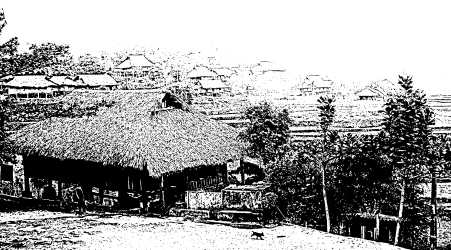
How many Viet Cong are in this picture? The answer may surprise you!
By default, Units share awareness information--if one member is aware of something, the whole Unit is. Also, once you've pegged something, you can keep track of it out to twice your normal detection range. (This, incidentally, is how spotters work for snipers. The spotter can have a high Vigilance, leaving the sniper to dump all his points into Proficiency for taking those long-range shots. As long as they stay within 10 meters of each other, the sniper benefits from the spotter's detection range.)
Anyways, this situational awareness is vague and impressionistic, not specific. Your GM will tell you things like "you see a few armed figures moving through the trees," not "you see five V.C. guerillas with AK-47s setting up an ambush." If you want more details, you'll have to spend an action Observing. If you've ever played Apocalypse World, this is basically the "read a person/sitch" move--roll Vigilance, and for every success equal to or over the Difficulty (which is the same as it would be to shoot them), you can ask a question about the makeup, armament, intent, etc. of the Unit. Careful, though--if you FUBAR, the GM can lie to you on one question per failure over your successes. Binoculars are helpful here--they don't increase your detection range, but they do give you a hefty bonus on Observe actions.
But what about things that don't want to be seen? Stuff that's hard to see, whether that's a carefully-placed trap, a commando unit trying to sneak up on you, or just some fishermen out for a pleasure cruise on a moonless night through eel-infested waters, has a Stealth Rating. Stealth Ratings are simple--they get subtracted from your effective Vigilance for detection purposes. If something has a Stealth Rating higher than your Vigilance, you can walk right over it and not see it. Land mines tend to have a very high Stealth Rating. Other things can have Stealth Ratings by virtue of the environment (e.g. darkness, fog, torrential rain) or active concealment. There's an Infiltrate action that lets you move at half-speed while giving yourself a Stealth rating, but weirdly there's no opposite equivalent that lets you move more slowly but increase your Vigilance. There's the Sentry action that gives you a bonus to Vigilance, but it's a Regular action and is pretty clearly for standing guard, not making a cautious sweep, and there's the Search action, but that's specifically for searching a person, place, or thing.
Finally, it's pretty easy to track things through a jungle, even if you're not a ranger. Any group of 3 or more people, a vehicle, or any wounded character leaves a trail that you can follow. A character can pick up and follow a trail that's up to (Vigilance) Turns old. Larger groups add to that number, and vehicles add 1/10th their Weight to it. For reference, a Soviet Armored Car is Weight 400, so that can be a pretty long time.
Oh hey, remember last update how Exhaustion gives you a big fat penalty to Vigilance? Yeah, that applies to all of this, too.
Movement
Now that we know how to spot people, let's go say hello! We talked about calculating Load and Speed back in update 2, now we'll talk about how to use it. Speed has three components: how far you can travel with a Full Move, a Half Move, and a Shift (unsurprisingly, a Shift is half a Half Move, so 1/4 your Full Move). Most of the time, your movement is covered by the March action, which lets you make a Full Move. You can also Quick March, which lets you move twice, but reduces your Vigilance by 5 for the Duration and risks getting caught flat-footed if you make contact with the enemy. Shift is a Minor Action that lets you move your Shift distance, perform an action, then return to your original position as long as your action wasn't an attack. Handy for dragging a downed buddy back to the medic. There are a fair few other movement actions I'm not gonna go into a ton of detail on, but they include options like "half-move and attack," charging the enemy, and the aforementioned "half speed and sneak." On any of these actions you can Push Yourself, taking +2 Speed for every point of Exhaustion and Thirst you mark.
Terrain can reduce (or rarely increase) your effective Speed, and you always use the lowest speed value if you're moving through multiple types of terrain. You can split your Full Move into two Half Moves, if that's beneficial--like, if your Speed is 6 and you need to cross a -2 Speed stream, right next to you, you could make a Speed 4 Half Move to cross the stream, then a Speed 6 Half Move on the clear ground on the other side. It's kind of a fiddly rule, and it generally doesn't get you much more than 100m farther than a single Full Move would, so I'm inclined to ignore it.
If moving brings you into detection range of enemies within 300m, that's Contact. Your movement stops cold, and everybody involved makes an Evade action (no roll, +1 difficulty to hit you, your actions all have +1 Difficulty, and you take +1 Doubt.) If you're less than 100m away, you can instead take a Suppressive Fire attack, though it's considered blind firing. More on those in the combat update. Also, while you're aware of any enemy presence within 1 km, you can't make Full Moves--any action that lets you make a Full Move instead lets you make a Half Move. Finally, unless one Unit is unaware of another, hostile Units can't move through each other. They just stop at 10 m apart and engage in hand to hand fighting, which is... a bad idea.
Equipment relevant to moving around includes Footwear (without it, you're Speed -2 all the time) and bicycles and motorcycles. They increase your movement rate, not your Speed, but only on paved ground. They also count as equipment, not vehicles.
Terrain, Weather, and Structures
Ahh, fuck it, this update ended up fairly short, so let's talk about buildings and stuff--that still fits the theme of the update title, right? Rather than presenting a bunch of specific terrain types like "Jungle, Light" or "Mountain," PATROL gives us a small selection of features that we're encouraged to combine as necessary. Jungle, for instance, could be Difficult (Speed Down 1-3), Obscuring (as we covered up above) Terrain. Wade into a swamp, and you add Shallow Water (more Speed Down, ground vehicles can't cross). Rice paddies are probably Shallow Water and Dead Ground (no place to take cover in a firefight), maybe with Easy Trails between them.
Weather and time largely work the same way--time of day generally provides Stealth Modifiers, and since Vietnam is pretty close to equatorial, you can assume a roughly-equal number of day and night turns. PATROL uses a simplified lunar cycle of 7 day phases: Waxing, Full, Waning, and Moonless. Weather has a broader range of effects--rain causes Doubt if you don't have shelter, clouds double aircraft To-Hit modifiers from Altitude, and so on. Despite Vietnam being a tropical country, we get rules for blizzards and sandstorms just in case your game takes a hard left turn into alternate history or your PCs somehow kick off nuclear war. (Which is not that unfeasible, China tested their first nukes in the late 60s.)
Next up are Structures. PATROL tracks small and large structures a little differently--a small structure is generally anything less than 10m in diameter, probably without interior room divisions. They can provide Stealth Ratings to people inside, can negate Injury from small-arms fire if they're sturdy enough, and contain grenade blasts--it's much safer to toss a grenade into a building than an open field. (For you, that is. Not the guys inside. Obviously.) Defensive Positions are a special type of small structure--your foxholes, slit trenches, and so on. They have a Capacity (how many people fit in them), Level (how many Injuries they negate), and Stealth Rating. You will be digging a lot of these. Or you'll be dying.
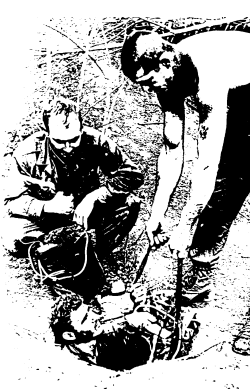
"It's dangerous to go alone. Take this!"
"Fuck you, Jerry."
Large Structures are anything at least mostly enclosed, with interior rooms, and not mostly empty space. They'll generally use their own interior maps, at least a crude sketch of one. Fighting in a large structure breaks down into a sub-system for room-to-room fighting--the normal Turn order is suspended, and Units inside the building take alternating single actions as they try to sweep and clear or defend their position. It all takes place within a single Turn, and it gets pretty intense. Even more intense are Tunnel Complexes, which are large structures with the added bonus of having to worm your way through tiny-ass tunnels to get anywhere while the V.C. try to machine gun your face off. Tunnel Crawl is a special movement action that uses your equipment's Weight as its difficulty, so travel light. Or, y'know, toss a few incendiary grenades down the hole to burn them out and/or eat up all the air. Probably safer that way.

Next Time: War! (Good God Y'All!) - Combat
War! (Good God, Y'all!)
Original SA post
Table of Contents
- Part One: Goodbye Sweetheart, Hello Vietnam
- Part Two: Fortunate Sons
- Part Three: Run Through the Jungle
- Part Four: Paint it Black
- Part Five: All Along the Watchtower
- Part Six: War! (Good God, Y'all!)
We have met the enemy, and he is us. Unfortunately, on a more literal level, he's also that Viet Cong company embedded on the ridgeline above our firebase, and we need to dig him out.
The basis of most combat actions is the To-Hit number, which is determined by the range to the target Unit. For small-arms, that ranges from To-Hit 2 at <50m, up to To-Hit 5 at 1 km. Heavy weapons can extend that range (and corresponding To-Hit) out to 25 km for artillery, but you pretty much need a shit-ton of fire support to hit anything at that range. A couple of things can influence that number, though. For one, if you're targeting an enemy unit based on sound, intelligence data, sheer paranoid gut suspicion, or other non-visual means, that's called Blind Fire and it increases To-Hit by one. On the flip side, if you're caught by surprise or in terrain with no cover, your To-Hit drops by one. (PATROL assumes that, if cover is available, you're making use of it, and factors it into the base To-Hit Difficulty.) Finally, while all small-arms can fire out to 1 km unless otherwise specified, attacks beyond your weapon's effective Range also increase To-Hit by 1.
As we've mentioned before, you don't generally target individual characters with attacks, you target Units, and resolve damage against randomly-chosen members of that Unit. The same poor bastard can get hit multiple times by a single attack, if the dice are unkind. If for some reason some members of a Unit have a higher To-Hit, you use the lowest To-Hit of the Unit and exclude the ones with a higher number. Oh, and crossfire is a thing--if your line of fire crosses within 10m of a Unit other than the target, that Unit can be random targets of your attack too. This is why you don't lay an ambush on opposite sides of a road, children.
We've mentioned Suppression in a couple of updates now, but here we can finally define it. A Suppression value is applied to a whole Unit, and it's generated to different degrees by various kinds of attacks. Each point of Suppression is -1 to Proficiency and to Speed. Moreover, if your Unit's Suppression + your Doubt exceeds the number of people in your Unit + 3, you're Pinned Down. That means you can't take any regular actions except to Evade, Flee, or Crawl.
Small-Arms Combat
Small-Arms' bread and butter are the Suppressive Fire and Precision Fire Actions. Suppressive Fire, unsurprisingly, primarily focuses on putting Suppression on enemy Units: one per Success that matches or exceeds the To-Hit number. For every multiple of the To-Hit you roll in successes, you also score a single Hit on one random target. Suppressive fire in a close-range ambush can absolutely chew through enemy infantry, but the damage on those Hits is low enough that they're unlikely to kill anyone. Failures on Suppressive Fire use up ammo--which leads to the admittedly odd-seeming edge case where you might hit 5-6 enemies and not actually use any ammo. But hey, ammo is abstract, so don't worry about it.
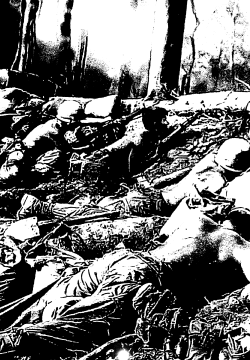
Remember Defensive Positions? You should.
Precision Fire, on the other hand, only ever inflicts 1 Suppression and 1 Hit, but that hit inflicts more damage based on excess successes. It also only uses a single ammo--but, after a successful attack, you can attack again--mark another ammo, discard any Failures you've rolled so far, and increase To-Hit by 1. You can keep going until you miss, run out of ammo, or FUBAR.
Even Precision Fire hits a random target, so if you want to specifically take out that machine gunner or officer, you'll need to Take Aim.It's a minor Action with a Difficulty equal to your Suppression, and every success lets you choose from a list of options: hit a specific target, reduce the target's Injury Reduction (e.g. from a Defensive Position) by 1, or get +3 on the attack. I assume this should be read as "successes matching or exceeding the Difficulty," but it doesn't say that--nor does it say if you can pick the same option more than once. The biggest downside to this is that if you fail the Take Aim action, you lose your regular Action this turn.
But maybe precision isn't your bag. Maybe you prefer to Throw Grenade(s). Every Success matching or exceeding To-Hit with a grenade is a hit on the target Unit--but every failure is a collateral hit on a different Unit within Close range. (You can ignore failures if you successfully lob a grenade into a structure or a defensive position, because then the walls contain the blast). FUBAR? Yeah, you dropped it at your own feet. (Or maybe an on-the-ball enemy tossed it back). You can always dive on it and take double damage to spare your buddies. Even though the action is called Throw Grenade, it's still what you roll for grenade launchers or RPGs--the weapon itself determines the maximum Range, while the grenade itself determines the effects of a Hit. Throw Grenade is a special action, in that you can do it as a Minor or a Regular action--so you can throw two grenades per turn, move and throw, throw and shoot, etc.
There are also special actions for Executing prisoners and Assassinating unsuspecting targets--weirdly, Assassination requires a melee or silenced firearm--seems to me you can assassinate someone just fine with an unsilenced weapon, it's just that you won't stay hidden after that.
Your choice of weapons has a lot of impact on your combat actions--different guns are capable of different attack actions and have different modifiers. Your basic assault rifle (whether the M16A1, AK-47, or, God help you, the original model M16 that jammed all the damn time) is a Medium-range weapon that can make Suppressive or Precision Fire with a +3 to each. Meanwhile, Dutch's shotgun is only capable of Suppressive Fire, but gets +5 attack and +1 damage at Close range. It also ignores the jam result of a FUBAR attack roll, but reloading it is a Regular action. And as for Vasquez's heavy machine gun? It's Suppressive only, with a whopping +6 to attack. It also inflicts +2 Suppression and +2 damage, and it has 1 Armor Penetration (2 at Close Range). We'll cover AP in the Vehicles update, but this gun is a beast. The flip side is that it's heavy as fuck, has to be assembled before use, and it uses Heavy Ammo, which weighs twice as much as regular Ammo.
Melee Combat
If you close to within melee range with an enemy Unit, everybody in both Units pairs off and rolls opposed Fortitude checks. Whoever gets the most successes wins, and depending on your initial intent the loser either takes damage, is stunned for a Turn, or flees. However, for every Failure, you take an Injury, and no matter what everyone involved ticks Exhaustion. TL; DR you have a rifle for a reason, use it.
Heavy Weapons
Direct-fire heavy weapons, including flamethrowers, tank cannons, recoilless rifles, etc. use the Blast action. It's a lot like Throw Grenade, except you only risk collateral damage on a FUBAR and it's always a Regular action. The type of shell fired dictates the effects of the Hit, while the weapon used determines the size of the shell and thus the magnitude of the effect. It's a neat little system--individual munitions' effects are described with X or Y (e.g. X Damage on all units within Y), while a small Size chart gives you the numbers to plug in. For playability, the game assumes that any kind of weapon can fire any kind of shell, but if you're historically minded you can limit that. (My personal favorite heavy munition is the Leaflet Shell, which just dumps a ton of propaganda on the targeted unit.)
Artillery
Indirect-fire weapons use the Bombard action, and it is immensely satisfying. (Technically, most of the time it'll be an NPC rolling the Bombard, but it's good form to let the player who called in the strike roll.) Every range band includes a Deviation, ranging from 25m at Medium range up to 500m at 25km Maximum range. Every success meeting or exceeding To-Hit on the Bombard is a Hit on every Unit within Scatter distance. What's Scatter distance, you ask? Well, it's Deviation x number of Failures on the Bombard action--careless artillery can easily lay waste to huge swathes of jungle. Also, without a spotter, indirect fire is almost certainly Blind Fire, which increases the To-Hit by 1. Also, for every assistant the gunner has, you can consume 1 more shell to fire again, using all the dice that didn't roll successes or failures before. You can keep going until you run out of dice, ammo, or assistants--but the end result is that an artillery barrage is a literal clatter of dice after dice after dice hitting the table.
Spotters use the Spot Target action, which, if successful, allows the gunner making a Bombard action to treat your sight as their own--I'm not sure if this means calculating To-Hit or just for Blind Fire purposes. Additional successes negate failures on the Bombard action, keeping the Scatter distance down.
All of these combat actions have made me realize something, though--unless I'm missing it somewhere, there aren't any rules for what happens if you just plain don't roll enough successes to meet the To-Hit. I guess you can assume that the attack goes off in some random direction with no effect, but for a game that's been so meticulous about unintended consequences so far, it seems odd to not deal with stray bullets or errant artillery fire.
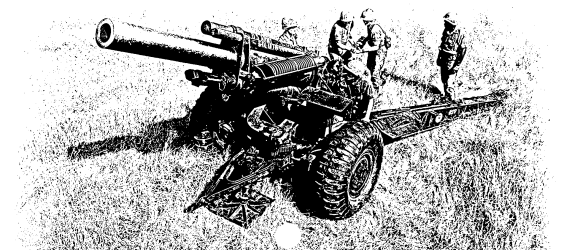
All of that is for one gun. A typical, average-sized US Firebase had six of these.
Armour
Armour hasn't really come into its own yet in the Vietnam War, but protective equipment like flak vests sometimes gives you an Armour Save. Basically, roll 1 die for every Injury you take--every die that comes up equal or higher than the Armour Save value negates one Injury.
Casualties
Infantrymen are remarkably fragile--5+ Injury kills them dead. In the event that you get injured and don't immediately die, you have to make a Shock Check. The Shock Check is a Fortitude check with a difficulty equal to your Injury--if you pass, you don't pass... out, that is. Failures, however, inflict Ongoing damage as you start to bleed out. Hopefully one of your buddies can patch you up with a Treat Injury action, which can either either remove 1 Injury or cure ongoing damage. If you're badly hurt, though, your buddies might be better off trying to Stem the Bleeding until the Medic can get to you--and even he might need to set you up with a Transfusion to keep you alive while he patches you up. (IOW, the difficulty of Treat Injury is your total Injury rating, while Stem Bleeding and Transfusion are Difficulty 1. Transfusion does a way better job dealing with Ongoing Damage, but requires specialized gear and either a compatible donor or blood plasma.)
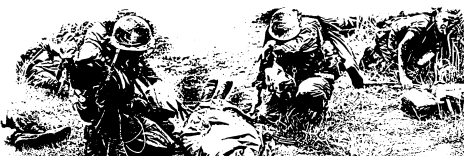
A wise soldier keeps his squad's Medic well stocked with booze and smokes.
But suppose all that's not enough and you're still KIA in the field. The good news is, your replacement character receives all the XP your previous character had accrued, including what they would have gotten for the mission they died on. If your buddies bring your body home, you get +5 bonus XP--if all they can recover are your dog tags, you get +3 XP instead. If your character leaves play as a defector, deserter, or POW/MIA, you get differing amounts of XP, ranging from "none whatsoever" to "just what you would have gotten for your last mission."

Next Time: Guns and Ships - Vehicles. Yes, I know, it's not a Vietnam War song, but I can't think of anything more appropriate right now.
Guns and Ships
Original SA post
Table of Contents
- Part One: Goodbye Sweetheart, Hello Vietnam
- Part Two: Fortunate Sons
- Part Three: Run Through the Jungle
- Part Four: Paint it Black
- Part Five: All Along the Watchtower
- Part Six: War! (Good God, Y'all!)
- Part Seven: Guns and Ships
Unsurprisingly, jungle warfare isn't terribly friendly to most vehicles, but both sides of the conflict deployed tanks and self-propelled guns as infantry support, and of course there are few images of the war more iconic than the Huey gunship/medevac chopper.
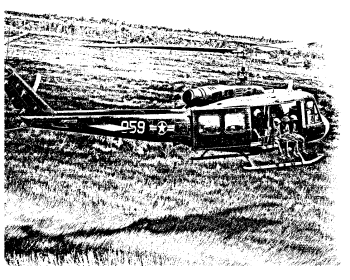
Officially the UH-1 Iroquois, but only FNGs call it that.
Accordingly, PATROL's vehicle rules are fairly simple--there's enough depth there that you could play an US Army tank crew (or the various commanders of a tank brigade, if you want MOAR TANKS) or US Navy/Marine patrol boat crews (insert dated John Kerry joke here). An Air Force game is probably outside the scope of the rules, though.
Anyways, we've already seen a couple of Vehicles' special rules--they always count as their own Unit for targeting purposes, and you can see them from much farther away than infantry. Also, vehicles don't take suppression--though characters riding on them can--and since tanks don't take cover, they effectively subtract 1 from all To-Hit numbers, just like characters who are being ambushed.
Vehicles have a Speed stat, but it's presented slightly differently--ground vehicles have a max. Speed and a combat Speed, the latter of which they're limited to in combat scenarios or Difficult Terrain--the actual Speed Down rating doesn't matter, so it's down to GM discretion how Difficult is too Difficult for a vehicle. Aircraft instead have a maximum and minimum Speed--they're not limited in combat scenarios, but they have to move their minimum Speed to avoid crashing. Yes, even helicopters--remember that Turns are 30 minutes, and the helicopter hasn't built that can hover that long without the engine overheating. Vehicles have a Fuel capacity as well, and burn 1 Fuel every X turns of operation--X depends on the vehicle, so you'll want to be ready to mark up the Roundel if you need to track a vehicle's Fuel consumption. Happily, with one exception (I'm looking at you Soviet rocket artillery truck), all of the vehicles in the book burn fuel at a rate that divides evenly into 12, so you don't have to worry about not lining up with the Roundel.
Armour tells you how tough a vehicle is--any attack with Armor Penetration less than the vehicle's Armour are straight-up ignored. (In a nice touch, AP is usually a random value, so tank duels are a little more interesting than "I can damage this tank/I cannot damage that tank.") Virtually no small arms have any AP. If you see a tank, pray it doesn't see you. (Fortunately, it probably won't.) Instead of Injury, vehicles have a Damage track, though it has no ongoing penalties associated with it and just serves as the Difficulty for Shock checks. Toughness is what vehicles roll for those checks, and just like a character, if it fails the roll it's disabled. Unlike a character, getting an M41 Walker Bulldog back up and running is a lot harder than slapping an infantryman back to consciousness. Also, if a vehicle takes damage equal to its Toughness in a single attack, it's catastrophically destroyed and everybody dies.
Hey, you want rules for running people over with a tank? 'Course ya do! If a vehicle drives over a Unit, the driver makes an opposed Operate Vehicle action vs. everybody in the Unit's Fortitude. Andone who loses takes 1d3+1/100th the vehicle's Weight in Injury. Vehicles range from 60 for a jeep or civilian car up to 650 for a British-built Centurion Mk5 tank. Defensive positions can still reduce this damage, but if you're driving a Vehicle whose Weight is over 300, you can collapse foxholes by doing donuts on them. This automatically kills 1d3 people in the foxhole and may be the most
 thing in the game. Except maybe this sentence:
thing in the game. Except maybe this sentence:PATROL posted:
Any incapacitated, immobilized, restrained or consenting characters run down by a tank or similar are instantly killed.
Vietnam, y'all! On a less murderous note, you can take cover against a friendly or disabled vehicle and treat it as a Defensive Position equal to the vehicle's Armour--so huddle up close to those Armour 5 main battle tanks.
Next up is how you load crew into a vehicle. Every vehicle has a number of crew "slots," which can either be "In" the vehicle or "On" it. Characters In vehicles benefit from the vehicle's armor and aren't exposed to attacks, but have a tougher time bailing out if something goes wrong. Characters On the vehicle... well, you get the idea. Attacks against a vehicle always hit the vehicle first, but any additional Hits can be randomly divided between the vehicle and anyone riding On it. "In" slots also put a cap on your Vigilance for purposes of Perception--although most such slots have a hatch you can pop to remove that limit, at the cost of being exposed (mostly--you still get some protection, like being in a defensive position). Finally, if the slot has any weapons or equipment it controls, that's listed here. If a crewman controls multiple weapons, he can fire all of them in a single Turn, even if it's normally a Regular action for each. He can either direct all the attacks at a single target, or sacrifice one or more attacks as ranging shots to reduce the To-Hit with the main gun by 1 (to a minimum of 1.)
Aircraft work almost identically, except the Speed issue above, and the fact that they have an Altitude that works basically like (and in addition to) the regular Range rules. Aircraft also reduce the To-Hit for targets on the ground by 1 and ignore some Defensive Position, since a slit trench doesn't do much against a helicopter.
So, with all that terrifying firepower at their disposal, what can you, the lowly infantryman, do about a vehicle? Exploit that Visibility cap, for one. A fully buttoned-up NVA T-54 can't see anything past 50 meters or so in concealing terrain, which is enough for even a pretty slow gunner to stay out of range with a recoilless rifle and do some damage. If they pop a hatch to get some air circulation (it's hot as balls inside a tank--while it's not in the rules, I for one would treat being in a buttoned-up tank as being in Heat Wave conditions for purposes of Exhaustion and Thirst ticks) or improved visibility, a sniper can dissuade them real quick. And if you can get in close enough with a crowbar, you can pull my favorite trick in the game: Pry open a hatch and hot box the bastards. A Hot Box is a special Throw Grenade action wherein both successes and failures generate Hits on the vehicle's crew. (The action also doesn't technically say you have to be within 10m of the vehicle, but it's pretty clearly the intent. Also, the difficulty for prying open a hatch is listed as "Door," but there's no guideline on what that means.)
The book includes a decent selection of vehicles, including the expected jeeps, Hueys (both "Slick" and "Hog"--transport/medevac and armored gunship, respectively), a few varieties of FWF tanks, a military bulldozer (babysitting one of these while it clears jungle around a firebase--or to set up a new firebase--is a great mission), and... the M50 Ontos. Essentially 6 large recoilless rifles on a tracked chassis, it was designed as a tank-killer but was primarily used as infantry support on account of there not being enough enemy tanks.
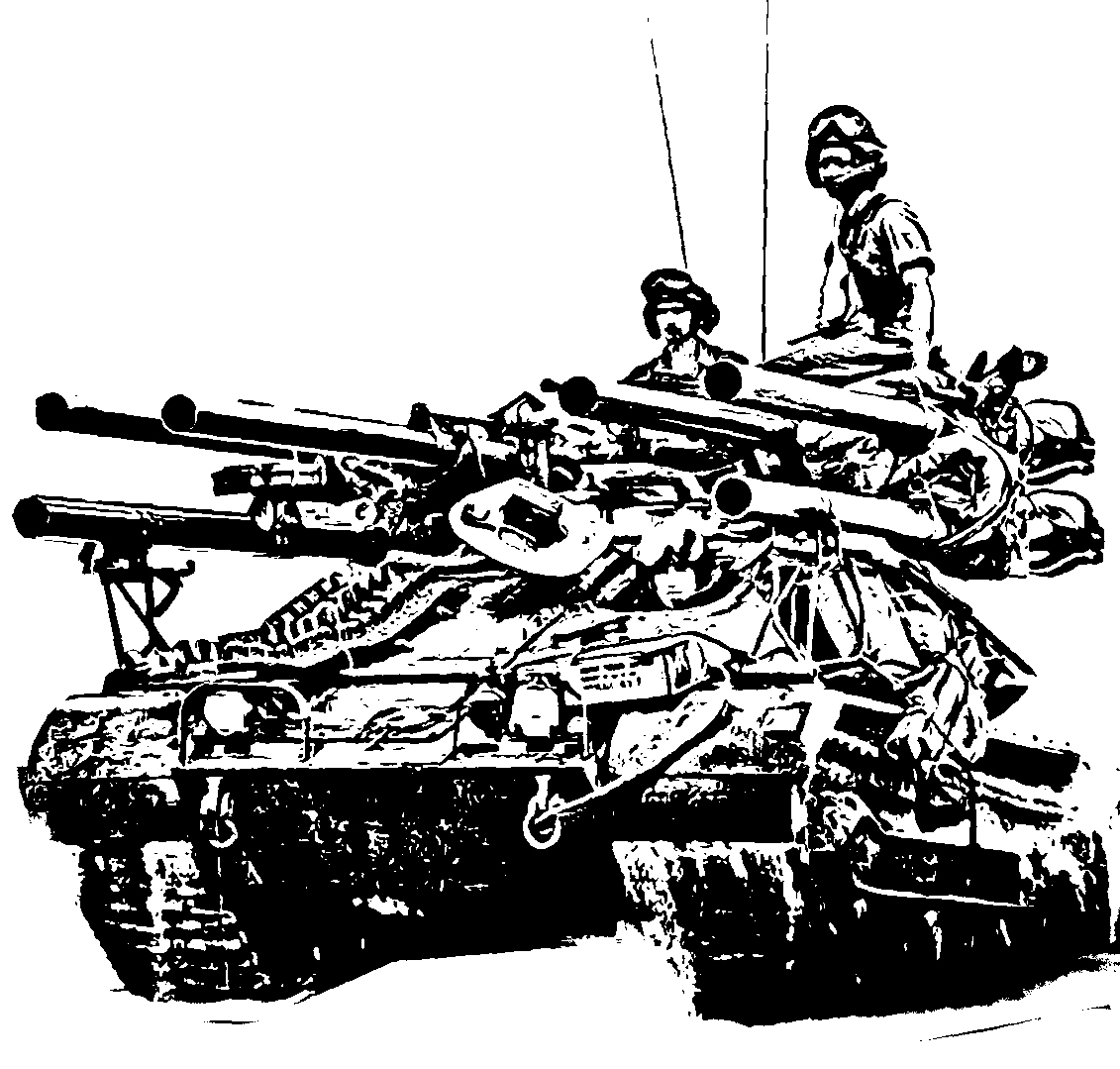
I had one of these as a kid. I'm pretty sure it came with an exclusive Cover Girl action figure.
Communist forces get slightly fewer varieties, and we only get one each of a generic "jet fighter" and "prop raider" for aircraft--which is fine, most of the Air Force is busy bombing the same railway bridge every couple months north of the border. Jet fighters do have a neat ability to "go supersonic," burning 3 Fuel to get anywhere in the country in a single turn, but you're probably not going to see them much in a reasonably historical game.

Next Time: Everybody's Talkin' - Communications. This will probably be the last of the rules updates--I might do one more sweep of miscellaneous cool stuff that hasn't quite fit into any of the main topics, depending if there'sd enough stuff to go in such an update. Otherwise we'll move on to the (really excellent and well-researched) setting and GM information parts.
Everybody's Talking
Original SA post- Part One: Goodbye Sweetheart, Hello Vietnam
- Part Two: Fortunate Sons
- Part Three: Run Through the Jungle
- Part Four: Paint it Black
- Part Five: All Along the Watchtower
- Part Six: War! (Good God, Y'all!)
- Part Seven: Guns and Ships
- Part Eight: Everybody's Talking
One of the most important rules of interaction in PATROL (at least, in the standard game mode of "US Army infantry patrols") is the language barrier. No PC is fluent in Vietnamese or any of the numerous indigenous languages spoken in-country. You can get buy the Local Languages Skill, but that only gives you some very basic grammar and vocabulary. Otherwise, you're reduced to using a Phrasebook (which at least gives you a +2 to your communication attempts) or Leaflets (which can automatically convey a single, simple concept; you can get 5 of them for 1 Weight and you decide what the leaflet says when you use it). PCs will never have a direct conversation with locals--it's always filtered through an interpreter or the Communicate Action.
Naturally, this language barrier, coupled with the insurgent nature of the OPFOR, leads to a fair bit of paranoia on both sides. If you're feeling twitchy, you can conduct your interaction "Weapon Up"--you'll take a Difficulty increase on the interaction, but if they try any shit you can attack or get the hell out of Dodge.
But maybe you're more the carrot type than the stick type--a sufficient bribe can grant an automatic success on a Negotiate or Interrogate action, assuming the other person wants the bribe and is amenable to bribery--otherwise you might just jack up the difficulty. Weapons, ammo, and medical supplies/services are all good bribes in most situations (there's even a specific Administer Care action for your medic to go among the sick and win some hearts and minds), desperate people will take food and water, and damn near everybody will accept tobacco. (Note that bribes work on fellow Americans as well as locals, but you might have difficulty communicating the concept across a language barrier.) The Army also provides Development Kits, which are basically a bribe-in-a-box: basic medicine, clean water, candy, and so forth that are generally valued in-country.
The bread and butter of interactions is the Communicate Action. Roll Vigilance, and for every success you can make one question understood, understand one answer, or convey one simple concept. Simple answers like a binary yes/no or pointing to indicate a direction don't use up a success. Lucky for you, there are no special effects for failures or FUBAR--personally, I'd be inclined to say a FUBAR means you something is dramatcally misunderstood--either they don't get your question, you don't get their answer, or you read hostile intent where there isn't any, maybe. Note also that this is purely about understanding--you can make a question understood, but nothing stops them lying right to your face.
Negotiate, meanwhile, is what you use to convince people to do things they don't want to do. Against people whose language you speak, it's a straightforward opposed roll, but to Negotiate across the language barrier, you'll have to roll some Communicates, too. You can always fire a Warning Shot before Negotiating (consume 1 Ammo for +1 success), or if you're feeling vicious you can inflict Small Violence--which nets you a bonus success on the Negotiate roll per success, but also inflicts 1 Injury per 2 Failures. Oh, and if you have 10+ Fatigue, 1s and 2s count as Failures. Hearts and minds!
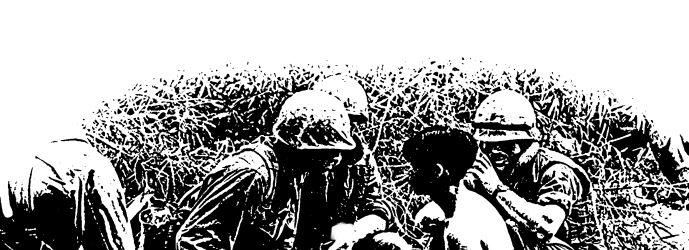
Try to read nothing sinister into this image after that last paragraph.
Finally, there's Interrogate--this does force them to answer truthfully, one question per success--but the GM can lie to you on one answer per failure, because torture doesn't actually work. If you FUBAR, you inflict one Injury per excess Failure. And once again, if you're interrogating someone across the language barrier, you'll have to use Communicate actions to actually understand anything you're getting out of them--assuming you even care. Also, there's this:
PATROL posted:
Spare Battery
Electronics need to be powered, but battery technology is not all it could be. Most equipment is charged either through blocky, non-rechargable 4 pound batteries, or large racks of cell batteries.
Type Supplies
Weight 2 XP Cost -
Consume to recharge electronics.
• Can be used with Tool Kit to give +4 on Interrogate Actions.

Epilogue
When you finally come back from a Mission, it's time to fill out an after-action report. Detailed accounts of actions taken and mission outcomes are vital strategic elements of prosecuting a war--fortunately, your character does all of that boring stuff offscreen. All you have to do as a player is Accusations and Commendations. Ideally these should be done at the table, with no cross-talk as players fill them out, but official policy and reality are often strangers, so you can do them by e-mail after the session if you don't mind the players having more opportunity for collusion.
To make an Accusation, write down any number of squadmates' names and indicate which military regulations they broke/which war crimes they committed. (No, you don't have to be telling the truth.) You can also recommend up to two squadmates for commendation. There's a list of medals and what they're typically awarded for; you can name squadmates and say which medal you're recommending them for and why.
Both accusations and recommendations are useless unless corroborated, so after everyone has written their after-action reports, the GM looks over them. If at least two PCs accused another of the same violation, the accused loses all Victory Points they accrued during the mission to their accusers. That's right, divide those VP up evenly and give them to the accusers instead. On the flip side, if you're the lone accuser, you lose all VPs from Objectives, though you still get VPs from other sources. For recommendations, if at least two PCs recommended you for a medal, you get the medal and a nice little VP boost, plus maybe a promotion. The exception is the Medal of Honor--if you want that puppy's 20 VP and automatic double promotion, every other member of your squad has to nominate you. If the medal was awarded posthumously, your next character gets half the VP as XP.
Assuming you're going on another Mission, the next step is to compare your final VP totals to your final Fatigue. If you have more VP than Fatigue, congratulations! You get the difference in XP, which you can spend on improving Attributes, new Skills, or Equipment. If, on the other hand, you have more Fatigue than VP, you have to reduce Traits to make up the difference. Yikes. Then you add 1/4 your Fatigue to a rating called Trauma. Trauma is essentially your new minimum Fatigue. No matter what your Status Effects say, you start every Mission with Fatigue equal to your Trauma. If your Trauma hits 12, you get sectioned. Roll a new character.
Finally, after a few missions, you and the GM might agree that your character is "short"--that is, a short-timer whose tour is almost up. If you survive the next mission, you can retire that character and transfer all their accrued XP and VP to your new one.
Motherfucking TIGERS!
Okay, this has nothing to do with interactions or the epilogue stage, but it's kind of the last thing in the main rules section that didn't really find a home anywhere else but is too cool not to talk about. The game includes stats for a few varieties of animals you might run across in rural Vietnam, including horses, pack animals, elephants... and tigers. Tigers are a goddamn nightmare: Fortitude 10, Vigilance 10, +5 to Melee combat, and a base natural Stealth rating of 3. They move 600m per turn (minus 100m per Injury), ignore all Difficult Terrain, and always Infiltrate--meaning that on top of their natural Stealth rating they add (3x Successes on a Vigilance roll) to their Stealth Rating every turn. Happily, most of them avoid humans, but you hear stories, out there in the bush... stories of tigers that have developed a taste for human flesh, that pick off a squad one by one over the course of several nights. If one of those fuckers sets its sights on you, you'll never see it coming.
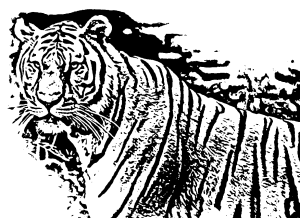
"I got yer 'fearful symmetry' right here, asshole."
And that pretty much wraps up the rules for playing PATROL! Overall it's a really solid, medium-crunch game that walks that fine line between providing a tactically-interesting wargame experience without glorifying a very morally questionable conflict and also providing a look at the psychological cost of war without coming across as exploitative or insensitive to the reality. I can't wait to see what open_sketchbook does with the eventual revised edition. For now, we're done with the crunch, but there's a ton of good resources left to cover on military tactics, the Vietnam War itself, and the geopolitical situation in Southeast Asia that both led to and came out of the conflict.

Next Time: Ain't Gonna Study War No More - Infantry Combat in the Age of Industrial Warfare for Dummies
Ain't Gonna Study War No More
Original SA post- Part One: Goodbye Sweetheart, Hello Vietnam
- Part Two: Fortunate Sons
- Part Three: Run Through the Jungle
- Part Four: Paint it Black
- Part Five: All Along the Watchtower
- Part Six: War! (Good God, Y'all!)
- Part Seven: Guns and Ships
- Part Eight: Everybody's Talking
- Part Nine: Ain't Gonna Study War No More
Maybe all this tactical goodness and psychological trauma has you excited to play a Vietnam War RPG, but you don't know an M16 from an M203 or a Brigadier General from a full-bird Colonel. Maybe your sole knowledge of infantry tactics comes from Commando or old reruns of Sgt. Bilko. Never fear, PATROL has you covered with a detailed overview of military organization, strategy, and tactics. By the end of it:
PATROL posted:
you should be more than ready to serve your country as a make-believe soldier with dice.
(NB: I'm condensing a lot here, but it's all good information. Any errors in this review are entirely my own, not Erika's.)
Military Basics
The military is a bureaucratic organization whose mission statement is to win wars. As such, they have to have the ability to continue to function even as key parts of that bureaucracy and personnel are eliminated. On top of the staff turnover that also afflicts civilian bureaucracies, the military has to deal with hostile forces actively trying to destroy them.
Because of all this, hierarchy and chain of command are paramount. In a civilian job, not doing what your boss tells you to can get you fired. In the military, it can get you put in jail. For our purposes, we're chiefly concerned with three categories of rank:
Enlisted soldiers do what they're told. They have no authority over other soldiers, they just follow orders. Non-commissioned officers are usually promoted from within the ranks of the enlisted men and are responsible for turning their superiors' orders into reality. They're usually in charge of small groups of soldiers, but they don't actually set tactical or strategic objectives themselves--they just make sure the plans are carried out. Finally, officers are the ones who actually make the plans. Lower-ranked officers make tactical decisions about how to execute their objectives, while the higher-ranking officers set strategic goals for larger groups, up to and including the whole war. Unlike NCOs, officers typically aren't promoted from the enlisted ranks--they usually attended an officer training school, hold a degree, and are upper-class. Officers are also expected not to fraternize with enlisted men, because that erodes authority--there are a lot of other protocols that reinforce this divide, too, like how enlisted men and NCOs are required to salute officers and hold that salute until it's returned--unless you're in combat or there are known to be snipers lurking around or what have you.
Units of troops are similarly nested and come with lots of built-in redundancy. Whole books have been written about this structure, but in brief: Divisions are commanded by generals and made up of regiments (which are commanded by colonels), which are made up of battalions commended by Lieutenant Colonels, which are made up of companies led by a captain, which are made up of platoons led by lieutenants, which are made up of squads which are organized and coordinated by NCOs. Battalions are typically the smallest field unit for organizational purposes, and unlike most of the world, which organizes forces at the regimental level, the USA organizes on the division level.
Industrial Warfare
Consider, as an analogy for war, constructing a building. Yes, one is all about blowing shit up and one is about creating something, but that aside, the analogy is pretty apt. In the past, both involved a fairly few skilled workers directing the efforts of large numbers of unskilled laborers, because that was the only way to get things done. With the advent of modern technology, fewer people can do the same work by using heavy machinery: cranes and dump trucks or tanks and artillery, as the case may be. The vast majority of the people actually prosecuting a war will never see the people they're killing: they're shelling them from kilometers away, dropping bombs on them from thousands of feet in the air, and the like. Some guys with rifles aren't really the way you win a war any more.
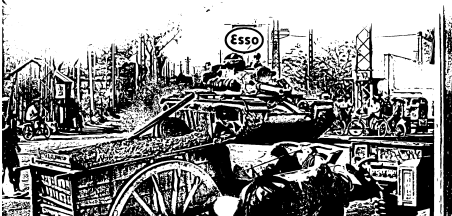
Coming summer 1969:
So, in this industrialized hellscape of modern warfare, what role does the infantry play? If we keep with our construction site metaphor, the infantry are security guards. See, those giant machines are great for large-scale carnage, but they're really vulnerable to individual people getting up close to them and wrecking their shit. Just like construction sites employ security to stop people from stealing the copper pipes or taking the bulldozers for a joyride, the military employs infantry to keep the enemy away from their big shiny artillery pieces and heavy armor. Infantry also gets the unenviable job of taking and holding actual ground, so things like airfields and firebases can be built and so Charlie can't creep up behind you. Most infantry fighting is in self-defense, and to help soldiers cope with the idea that their and their allies' lives are more important than the enemy's, a lot of effort is put into dehumanizing the enemy--which of course just makes atrocities that much easier.
About You
So who is the typical US infantryman in 196X, where X is > 5 but <9? Well, you're probably 19-20--a baby boomer, born in the huge population explosion and economic upswing in the aftermath of WWII. You grew up learning to "duck and cover" under your desk in the event of nuclear armageddon, hearing about men in orbit on the radio, and maybe, if your family was well-off, watching The Mickey Mouse Club. You grew up with the Civil Rights Movement and the assassination of JFK, and your teachers almost certainly spent a lot of time telling you about your "military obligation." As the war dragged on and the draft expanded, you were probably thinking about that a lot in high school. Your options were basically sign up and (maybe) get into a less-dangerous service, try to get a college deferment, or get drafted--in short, there was no real way to guarantee you weren't going to Vietnam, barring deliberately injuring yourself or draft-dodging.
And why are you here? Well, the prevailing theory of the day is that of the Domino Theory--basically, if one country falls to communism, so will its neighbors, and their neighbors, and on and on until we've got Reds in Mexico pushing into Texas! You might buy that line whole-heartedly, or you might think it's kinda dumb but communism is still pretty bad (you hear horror stories about Eastern Europe and South America, after all), or you might think the whole thing is just American imperialism or defense contractor fat cats lining their pockets or The Man's long game to pit the black man against the yellow.
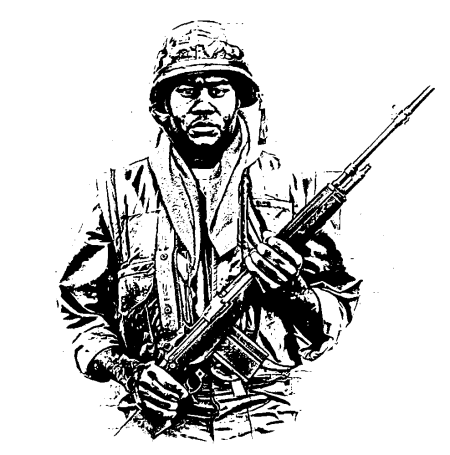
"How about 'all of the above?'"
Or, hell, the whole thing might just be a sick, pointless joke.
Garrison Duty
As an infantryman, more than likely you're posted to a firebase, more properly a fire support base or FSB. Think of them like old-timey Western forts out in the boonies--they range from little more than a few piles of dirt with a couple of pack howitzers to battalion-scale bases with multiple batteries of guns. The typical FSB, and likely your new home, consists of about six artillery pieces, a helicopter detachment, some engineers to build and maintain the place, and a company of infantry for security. The base itself consists of earthen berms and barbed wire barriers, with machine gun nests and watchtowers behind them, and makeshift "buildings" that are basically waist-deep pits with sandbag walls the rest of the way up to protect against mortar fire. Most of your days on garrison duty are spent carrying shit for the engineers, standing watch, or even shoveling out and burning the refuse from the trash pits and the latrines. Of course, since FSBs are the face of American occupation, you'll also face periodic mortar fire, sniper attacks, and the occasional "human wave" attacks where Charlie tries to overrun you with sheer force of numbers.
Patrol
It's the name of the game, and if there's one thing worse than garrison duty, it's a patrol. Basically, you and your platoon load up for combat and walk a beat through the bush, looking for trouble. If you're lucky, it's out in the morning and back at night--but if you were lucky, you wouldn't be in Vietnam, would you? More often you'll be out for a couple of days or weeks at a time, sleeping inside a perimeter of claymore mines as you check out known V.C. trails, visit nearby villages, and generally try to make it a little harder for Charlie to prosecute the war. Civilian life really can't prepare you for the combination of unbelievable tension and incredible boredom that is a combat patrol in Vietnam--you're pretty much guaranteed to run into the enemy, or at least their traps, at some point, but you can never predict exactly when. Maybe some bullets will whiz past your head, but usually by the time you realize it's happening and your body kicks out the adrenaline, it's already over, leaving you to deal with the aftermath. After a couple days on patrol, you might realize that Charlie lives like this all the time, and you start to see how a bunch of half-trained guerillas with shitty equipment can stymie the biggest military machine in the world.
(If you're "lucky," you might be stationed at one of the real bases around Saigon or Da Nang, where you have actual bunks and an actual mess hall and don';t have to worry quite so much about snipers and mortar fire. The flip side of that is that you're likely to get sent on much longer, more involved patrols, since there's so much more stuff for your commanders to play with.)
Short-Timers and FNGs
Every soldier in Vietnam is obsessed with time. Draftees are one a one-year tour of duty, and they can tell you down to the minute how long is left in their tour. When you're close to the end of your tour, you're a "short-timer," and your buddies will typically do their best to keep you off the most dangerous missions, or keep you safe when you do go out--because even in 196X, getting killed when you're two weeks from retirement is a shitty cliche no one wants to see happen. You'll also find yourself the target of re-enlistment officers trying to convince you to sign on for another tour, because the Army knows that rotating out its most experienced troops is a bad idea. (One analyst famously said "We weren't in Vietnam for ten years. We were in Vietnam for one year ten times," and that lack of institutional knowledge is a huge problem for the Army.)
On the other hand, new recruits are called FNGs ("fucking new guys") or "cherries," and they're generally hated because stupid naivete gets people killed. FNGs get all the dangerous shit jobs--you were most likely to die in your first two months in-country. Oh, and because officers' tours are six months field duty, then six months desk duty, the worst FNG in your unit? Probably your LT. Good luck.
About the Enemy
You call them the V.C., Victor Charlie. Your South Vietnamese allies call them the Viet Cong. They call themselves the National Liberation Front, and they're a guerilla force living out in the rural parts of Vietnam, trying to unify the whole country under the communist leadership in Hanoi. They live out in the jungle, or else they blend into the civilian population--anyone could be V.C. Most of the time, all you ever see of them are tracers ripping out of the jungle, booby traps set in your path, and the occasional body left after a firefight.
Depending on where (or when) you're fighting, Charlie can be anything from a poorly-organized bands of raiders hitting villages or lobbing grenades into passing trucks to a real no-shit army with organized brigades and officers and everything. On the other hand, the North Vietnamese Army, Nathan Charlie, is a whole other beast. For now, the presence of FWF troops means they can't mount a full-on war in the South, but plenty of them take off their uniforms and slip south on the Ho Chi Minh Trail to provide Victor Charlie with experienced officers. As things heat up, though, they start to make actual inroads into the south, rolling down with uniformed battalions, armored trucks, and artillery--hell, if you believe some of the rumors from the Marines in I Corps, they've even got tanks and helicopters.
The V.C. employ lots of terror tactics--they plant bombs in public places, they assassinate teachers, doctors, and clergy, and they kill anyone who doesn't toe the party line. They are a huge threat to the rural people of Vietnam--but at the same time, any of those rural people could be Charlie, and for every village that hates the Viet Cong and is willing to help you drive them off, there seems to be another that either doesn't care, hates you more, or is actively helping them. There's simply no way of knowing who you can trust.
The Kill Ratio
Because the Viet Cong is a dispersed, guerilla fighting force, there's no conventional victory condition in this war. You can't just roll a column of tanks into Paris and liberate it or take a chain of islands from the Imperial Japanese Navy; Charlie will fight until they win or they're all dead. Ergo, your commanders have devised the Kill Ratio strategy: basically, your goal is to kill as many V.C. as possible, while limiting your own casualties--command estimates that Free World Forces kill 10 V.C. for every one soldier they lose--if that ratio can be kept up, we'll win the war through attrition in short order. Why no, that certainly doesn't mean that troops will artificially inflate their kill counts by counting (sometimes inflicting) civilian casualties, or that the war will become a grinding slog that chews people up morally and psychologically, why on earth would you think that?

Next Time: These Boots Were Made for Walking - How to not get killed on patrol.
These Boots Were Made for Walking
Original SA post
Table of Contents
- Part One: Goodbye Sweetheart, Hello Vietnam
- Part Two: Fortunate Sons
- Part Three: Run Through the Jungle
- Part Four: Paint it Black
- Part Five: All Along the Watchtower
- Part Six: War! (Good God, Y'all!)
- Part Seven: Guns and Ships
- Part Eight: Everybody's Talking
- Part Nine: Ain't Gonna Study War No More
- Part Ten: These Boots Were Made for Walking
Historically, boots on the road is how armies have moved from place to place. All that marching they drilled into you in basic wasn't just for show, though--it was teaching you how to walk to a set pace, which is vital for getting large groups of people from point A to point B on foot. Without a pace, people walk at their own speed, which leads to your unit being bunched up or stretched out on the road, which not only leads to delays and communication problems, it leaves you vulnerable to ambush. This kind of marching is usually only to get from base to base or staging area--soldiers haven't marched this way in battle since the age of muskets. (Well, not effectively, anyway.)
The modern army is motorized, which means the infantry actually has cars and trucks assigned to it, so most of the "marching" you'll do is actually riding. Still, Vietnam isn't exactly friendly to large vehicular convoys, and in the theater of war things always go wrong, so you can expect to end up on the old two-foot express plenty often.
Now, combat movement, when you're in hostile territory and expecting enemy action, is a whole other kettle of fish. The first and most important thing to do is to keep distance between your squad members--bunching up is just asking for Charlie to lob a grenade into your midst or open up on you with a machine gun. The ideal distance is said to be a 5-meter gap between soldiers--close enough to easily keep track of each other, but spread out enough that your unit is more empty space than soldier. (I'll note that this is good real-world advice, but since mechanically a Unit is defined as "any group of people with no more than 10 meters between any of them," this spread has no actual effect on the enemy's odds of hitting you.) Beyond that, you should avoid worn trails, move in dips in the terrain, and for God's sake never walk along a hill or a ridgeline where you'll make an obvious silhouette.
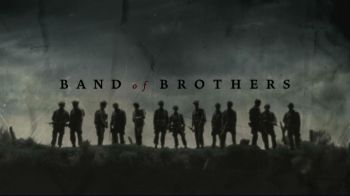
Shortly after this photo was taken, all thirteen of these men were shot by snipers.
The most common formation for a squad on patrol is Mobile Overwatch, in which the Point ranges ahead of the rest of the unit as a scout and pathfinder. If the enemy ambush him alone, they blow their surprise against the rest of the squad--and if they wait to hit the rest of the squad, the Point can double back and flank them. The rest of the team moves along behind him, single file and slightly staggered, with each soldier watching a specified direction. You usually put your heavy weapons near the back of the squad, because if you spot the enemy, you'll want to pull up into an L-shaped ambush.
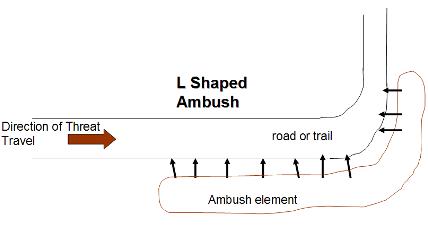
Much better than the H-shaped ambush.
This formation does a good job of boxing the enemy in without the risk of you shooting your own buddies.
Digging Holes
Let's be real, though; the thing that's most likely to kill you, the infantryman, is artillery--whether that's a Soviet-made piece fifteen kilometers away or the mortars carried by the V.C. raiders you've been tracking. Since artillery shells basically work by flinging large chunks of jagged metal relatively low to the ground, your defensive options are somewhat limited. Hitting the deck might help if you have enough warning, but the soldier's best friend is a hole that puts him below the contour of the ground. This will make sure the shell fragments fly over your head, and the dirt provides protection against the pressure wave of the blast. You'll want to make your foxhole as narrow at the opening as you can, though, because nothing's going to save you if a shell falls into it with you.
The Army has a lot of different classifications for holes, from the shallow "shell scrap" for sleeping and prone-position cover (also ghoulishly termed a "Ranger grave") to the shoulder-deep foxhole to the slit trench (which is basically just a long foxhole for the whole squad). If you have time, you can make yours more comfortable with a sump (a narrow trench in the bottom for drainage/emergency grenade disposal), a firing step, or a cover. Throw a camouflaged tarp over the top and you've got yourself a spider hole, perfect for letting Charlie pass by so you can pop up and attack from behind. Or, if you instead line the bottom of the hole with sharpened bamboo, you've got a tiger trap--one of Charlie's favorite tactics. (They like to go the extra mile and smear the spikes with animal venom or human feces for added risk of infection.) If you have to fight at night (and assume you're going to), you can pre-select a field of fire before you bunk down and mark out the start and end of your fire arc with sticks. That way you can tell by feel if you're shooting in the right direction.
This is My Rifle, Etc. Etc.
You know roughly how a gun works, right? Generally speaking, as PATROL puts it:
PATROL posted:
Guns come in many shapes and sizes. As a general rule, if it fits in your hand, its a pistol, and if its long and has a thing to put against your shoulder, its a rifle. If its somewhere in between, its a carbine.
Contrary to what you've seen in the movies, most gunfights happen at ranges around 200 meters, at which range gravity, windage, and other factors have a remarkable impact on your bullet's trajectory. Since time to aim isn't always a luxury in a combat situation, the general strategy is to shoot a lot of bullets and hope some of them hit.
During WWII, a combat historian named S.L.A. Marshall conducted a study that claimed that, in combat situations, 75% of soldiers would not fire their weapons with intent to kill, and many wouldn't fire at all. The US military took that study to heart, and now infantry training is heavily focused on "when in doubt, shoot, and shoot a lot." Countering the instinct to not harm your fellow man is a key part of military training doctrine. There's just one problem: Marshall's study was absolute bullshit. His methodology was trashed, and both logistical reports and accounts of actual veterans disputed it, but the Army top brass liked the theory, so soldiers coming into Vietnam were trained to vastly overcompensate for threats both perceived and actual. Best estimates are that US troops in Vietnam expended about 52,000 rounds for every confirmed casualty.
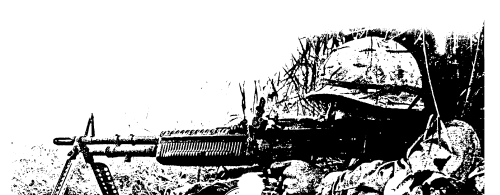
That's as many bullets as people living in St. Kitts and Nevis.
Next up, some popular misconceptions. Most enemy snipers aren't highly-trained badasses who can shoot the wings off a fly at 2 klicks--they're just guys with rifles who can get close on their own and take a shot before you start going for cover. Also, silencers don't make gunshots go "fwip fwip" like in the movies, they just make them go "THWACK THWACK" like an industrial staple gun. Also, a magazine and a clip are different things, but really only pedants and assholes get upset about the difference.
Next up is a brief history of service weapons, from the bolt-action rifles of WWI to the gas-operated semi-automatic of the M1 Garand, but we're mostly going to focus on battle rifles and assault rifles. Battle rifles, like the M14, are select-fire weapons firing full-sized rifle rounds, but since rifle rounds have ridiculous recoil, the automatic fire option was basically useless. The assault rifle was the answer; firing smaller, lower-recoil rounds for a more useful automatic fire mode. The iconic assault rifles of the war, of course, are the M16 and the AK-47.
The M16 was a revolutionary weapon in a lot of ways--lightweight, accurate, and balanced, but its original iteration suffered from design oversights and an inexplicable campaign advertising the weapon as self-cleaning (which no weapon on earth is), which led to a propensity for jamming. By the notional time frame of PATROL, the M16 has been mostly replaced by the M16A1, which fixed most of these issues, but the stories of dead Marines at Khe Sanh found next to their disassembled, jammed rifles have still tainted its reputation. The AK-47, by contrast, is famously reliable even in the worst conditions, but the V.C.'s problems with it were logistical: it was hard to get Soviet bloc ammo in South Vietnam, so both sides would frequently, albeit unofficially, steal weapons from fallen enemies. (Personally, I'd probably say the original M16 adds one Failure to all attack rolls for purposes of FUBAR, while the AK-47 negates one, but by the RAW they're identical).

Next Time: Boom Boom - Surviving a firefight.